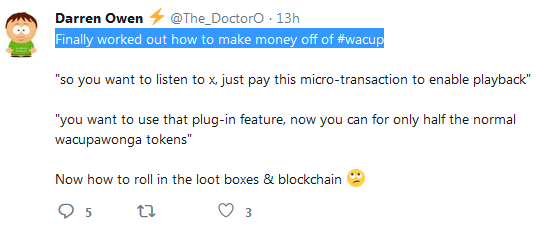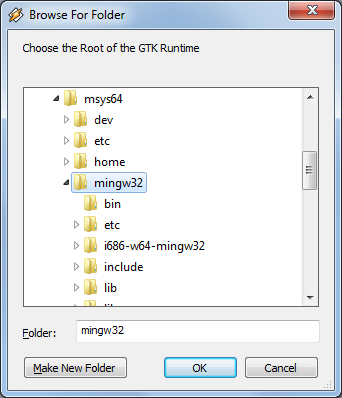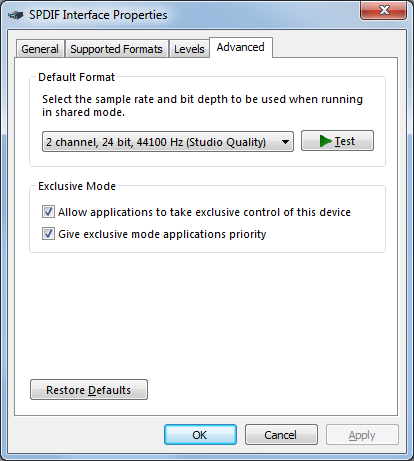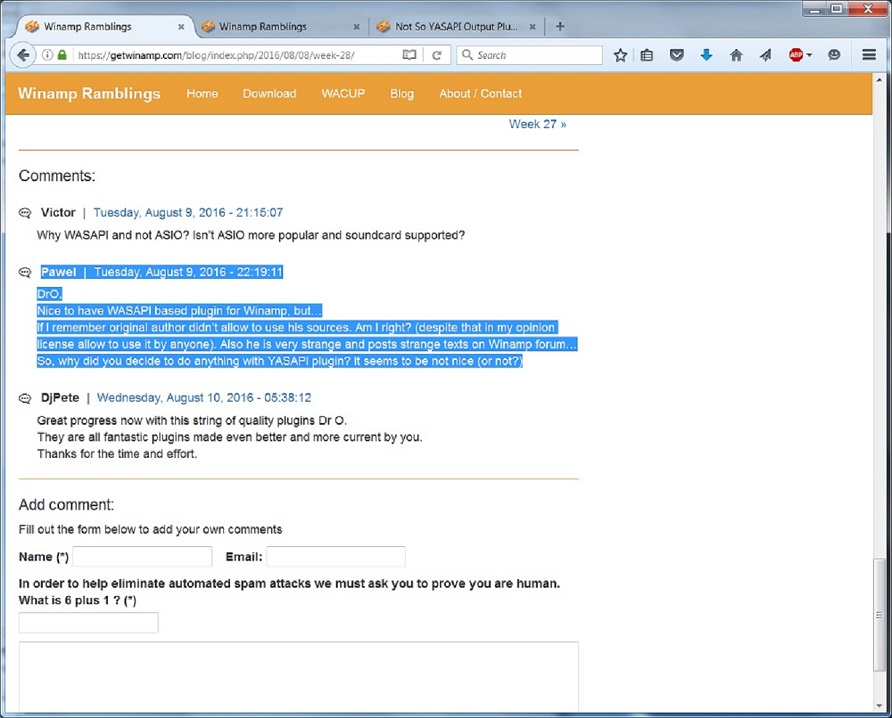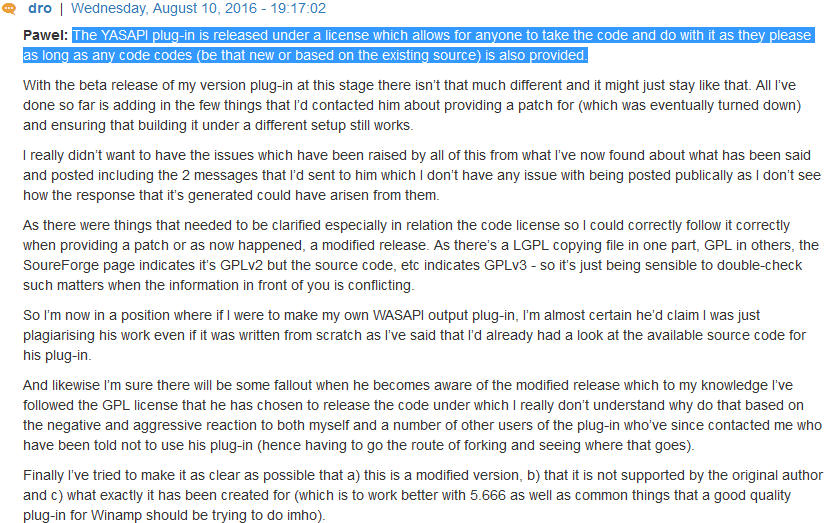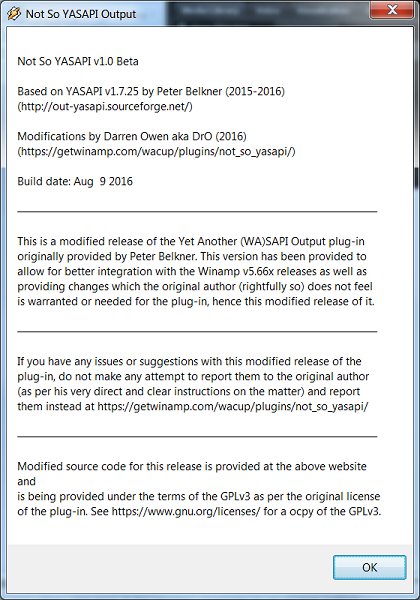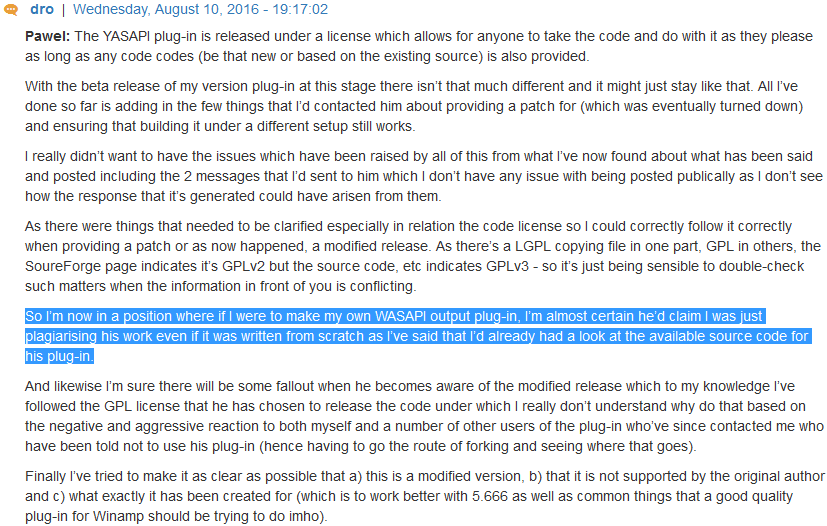| Date |
Release |
Remarks |
2020-06-03
pinned |
|
- As it seems our days at
Sourceforge
are counted. At least we’ve received a respective ultimatum:

Isn‘t it funny that this is happening at the exact same time as Donald J. Trump
is going to crack down all that commie scum?
- In order to comply with their “policy” we’re not any longer going to let host
this page by Sourceforge but have copied it already to http://out-yasapi.sourceforge.net/.
- Within a few days we’re going to remove it from Sourceforge.
- 2020-06-06
−
Because we’re not willing to follow the orders by Sourceforge this project
has to leave. As soon as there’s a domain pbelkner.de available expect a
revival of the project. Most likely
- this page will re-appear at
”http://www.pbelkner.de/software/web/out-yasapi/“, and
- the project’s releases at
”http://www.pbelkner.de/software/frs/out-yasapi/out_yasapi-2a/“.
|
| 2020-05-07 |
|
- Chris reported that the plug-in seemed not to load on Windows 10.
- Fortunately, this could be resolved by using the plug-in's gcc version.
- Hence we changed the default download from msc-bundle to gcc-bundle.
- Please note that the plug-in is developed on Windows 7.
|
| 2019-10-31 |
2.3.5 |
Made the plug-in more robust for being run from an unexpected environment.
(Many thanks again Ralf!) |
| 2019-10-21 |
2.3.4 |
- Brought back the dialog for choosing the installation directory of the GTK runtime
(cf. below) which for some unknown reason had been vaporized
(thanks a lot Ralf.)
- Corrected counting broken sessions.
|
| 2019-06-27 |
|
|
| 2019-06-02 |
|
- In case you try downloading "winamp58_3660_beta_full_en-us.exe" from
the source (i.e. from
winamp.com)
you may experience that it's not possible because their certificate
has been expired (already for some time):
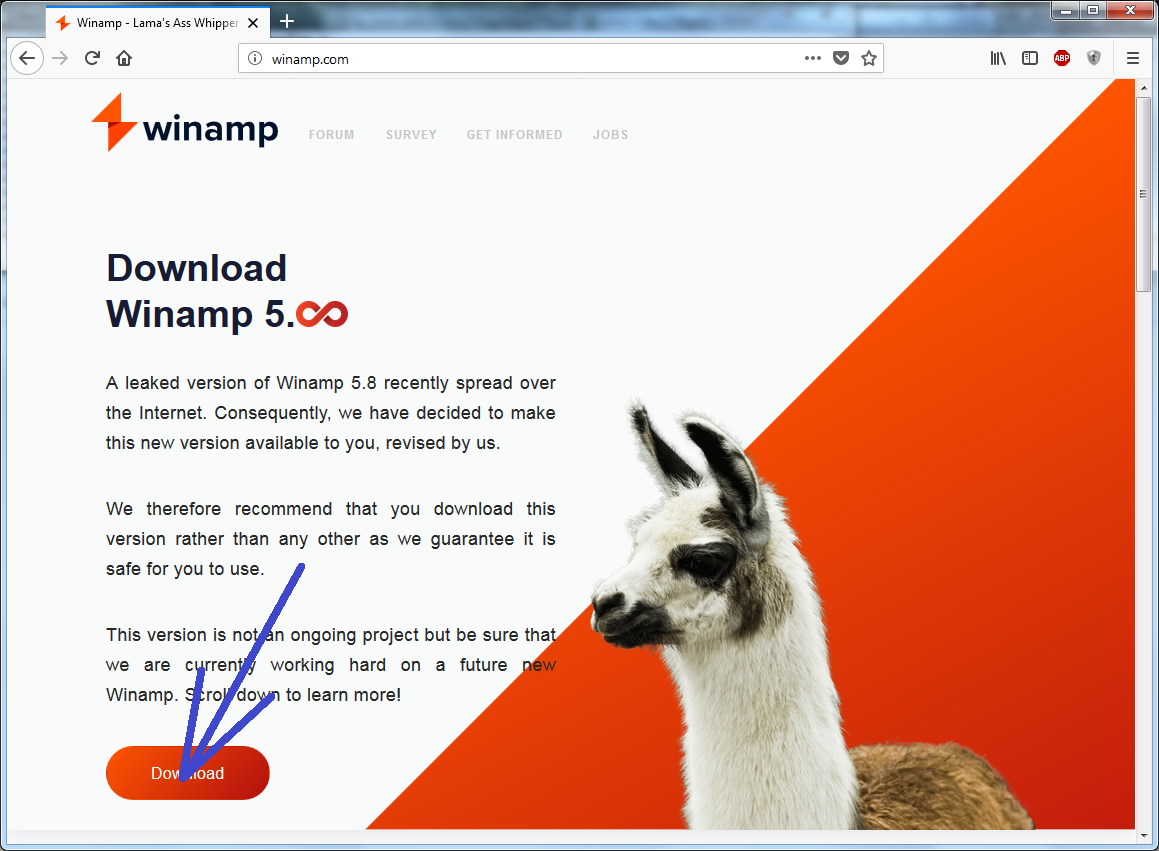 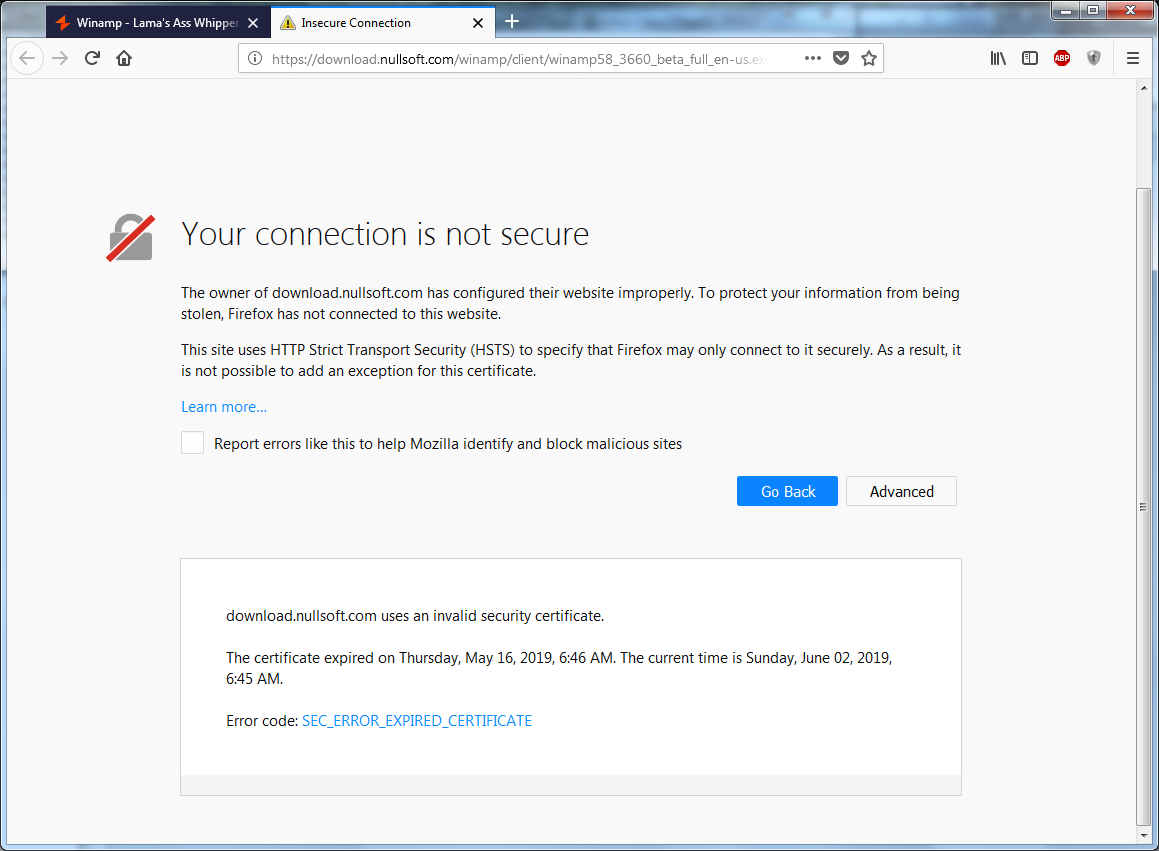
- It's, of course, possible to download e.g. by means of the
wget
command:
# wget 'https://download.nullsoft.com/winamp/client/winamp58_3660_beta_full_en-us.exe' --no-check-certificate
--2019-06-02 07:24:43-- https://download.nullsoft.com/winamp/client/winamp58_3660_beta_full_en-us.exe
Resolving download.nullsoft.com (download.nullsoft.com)... 5.39.58.66
Connecting to download.nullsoft.com (download.nullsoft.com)|5.39.58.66|:443... connected.
WARNING: cannot verify download.nullsoft.com's certificate, issued by ‘CN=Let's Encrypt Authority X3,O=Let's Encrypt,C=US’:
Unable to locally verify the issuer's authority.
HTTP request sent, awaiting response... 302 Found
Location: https://download.nullsoft.com/winamp/misc/winamp58_3660_beta_full_en-us.exe [following]
--2019-06-02 07:24:44-- https://download.nullsoft.com/winamp/misc/winamp58_3660_beta_full_en-us.exe
Reusing existing connection to download.nullsoft.com:443.
HTTP request sent, awaiting response... 200 OK
Length: 8201952 (7.8M) [application/x-msdos-program]
Saving to: ‘winamp58_3660_beta_full_en-us.exe’
winamp58_3660_beta_full_en-us 100%[=================================================>] 7.82M 1.68MB/s in 4.8s
2019-06-02 07:24:48 (1.64 MB/s) - ‘winamp58_3660_beta_full_en-us.exe’ saved [8201952/8201952]
- Update: Seems to be fixed.
|
| 2019-05-28 |
2.3.3 |
- Most likely you've read the following
message
a few days ago appearing on the Winamp forum:

- Because of that we ask some of our users we're convinced really
exist whether they can confirm because we're on a hopelessly outdated
Windows 7 system and hence cannot tell whether it's running
on Windows 8.1 or Windows 10 (apart from technical issusses
caused by drivers and devices.)
- As expected, the only thing they confirm is that it's up and
running. Many thanks to everyone contributing to the survey!
- One of the users, Diimaan from India, took the opportunity
to report some problems he experienced on his system with exclusive
mode where calling the
IAudioClient::Initialize
method was returning with some error message.
- Jointly we where able to resolve the issue with exclusive/push
(you may have noticed undocumented
v2.3.3-β1,
v2.3.3-β2,
v2.3.3-β3, and
v2.3.3-β4
needed for respective communications):
- The error code returned was AUDCLNT_E_UNSUPPORTED_FORMAT, an
error code
- This brouht us to the idea to introduce an additional call to
IAudioClient::IsFormatSupported in front of
IAudioClient::Initialize and voilà the issue was fixed.
(Please note that to our knowledge it is undocumented
that calling IAudioClient::IsFormatSupported
in front of IAudioClient::Initialize is mandatory.)
- Unfortunately, it was not possible to resolve the issue with
exclusive/pull where on Diimaan's system calling the
IAudioClient::Initialize
method repeatetdly returns with error AUDCLNT_E_BUFFER_SIZE_NOT_ALIGNED:
- Error AUDCLNT_E_BUFFER_SIZE_NOT_ALIGNED should be healed by the
alignment dance.
- Unfortunately, this doesn't help here because the alignment dance
has alredy taken place (indicated by repeatedly contained in
YASAPI/NT's error message.)
- Anyway, we found a bug in YASAP/NT's implementation of the
alignment dance and fixed it. Unfortunately, this doesn't help
either (we on our system are not able to test the alignment dance's
implemetation because error AUDCLNT_E_BUFFER_SIZE_NOT_ALIGNED is not appearing.)
- Thanks a lot Diimaan!
- This release is bundeled with the latest
v190528-0620,
of the GTK+ runtime.
|
| 2019-05-12 |
2.3.2 |
A few days after having published the
below fix, the issue
appeared again on our system. Of course, it is not sufficient to just have
the event object in place, we should also fire it when
un-pausing!
(Viewed this way the additional event object might be
completely superfluous - anyway, it doesn't hurt.)
|
| 2019-05-12 |
|
Ratatosk: German Doomer caught on camera |
| 2019-04-06 |
2.3.1 |
- In very rare cases we observed a deadlock when un-pausing with
YASAPI API
being active.
- We hope we've solved the issue by deploying a dedicated
event object
for synchronizing the YASAPI API.
|
| 2019-04-06 |
|
|
| 2019-03-14 |
|
Finally identified the
root cause
for stuttering and fixed it. That way we confirmed our hypothesis
that it was caused by loading due to the input plug-in. |
| 2019-02-28 |
2.3.0 |
- We're proud to announce that finally v2.3.0 has been released.
- It's essentially the same as v2.3.0-β13.
- It uses the latest
GTK runtime
providing updated versions of
gspawn-win32-helper.exe,
gspawn-win32-helper-console.exe,
libgdk-3-0.dll,
libgio-2.0-0.dll,
libglib-2.0-0.dll,
libgmodule-2.0-0.dll,
libgobject-2.0-0.dll,
libgtk-3-0.dll,
libharfbuzz-0.dll,
libpango-1.0-0.dll,
libpangocairo-1.0-0.dll,
libpangoft2-1.0-0.dll,
libpangowin32-1.0-0.dll,
libpcre-1.dll, and
libpixman-1-0.dll.
|
| 2019-02-02 |
|
Recently we observed what is best described as some irregularity regarding
the Sourceforge download figures.
- Starting with 2019-01-18 there's an obvious pre 2.0+ versions
boost
contributing significantly to the overall figure:
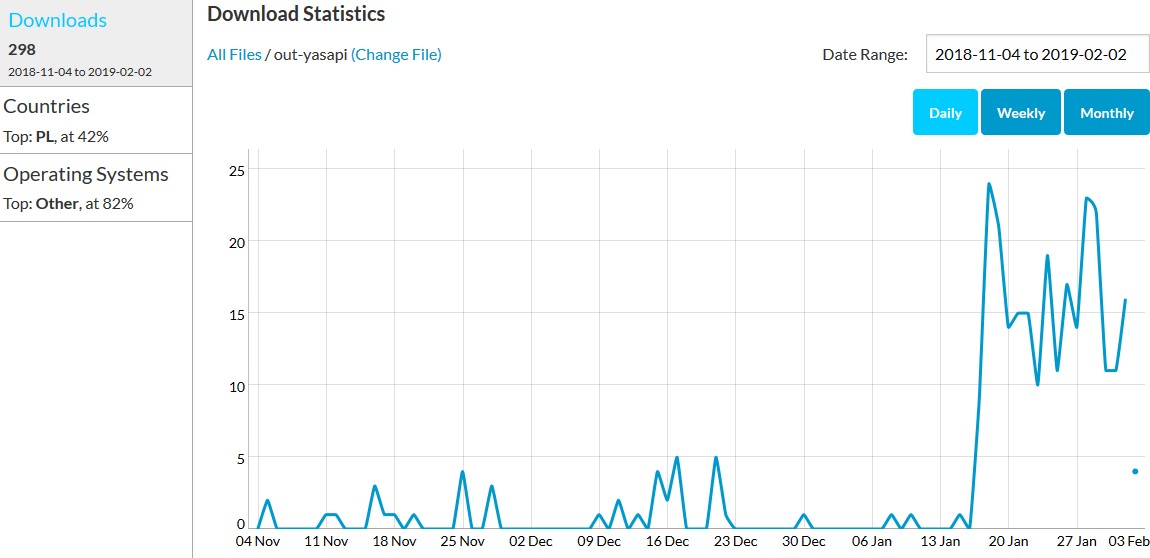
- With low contributions it
scatters
through most of the pre 2.0+ versions:
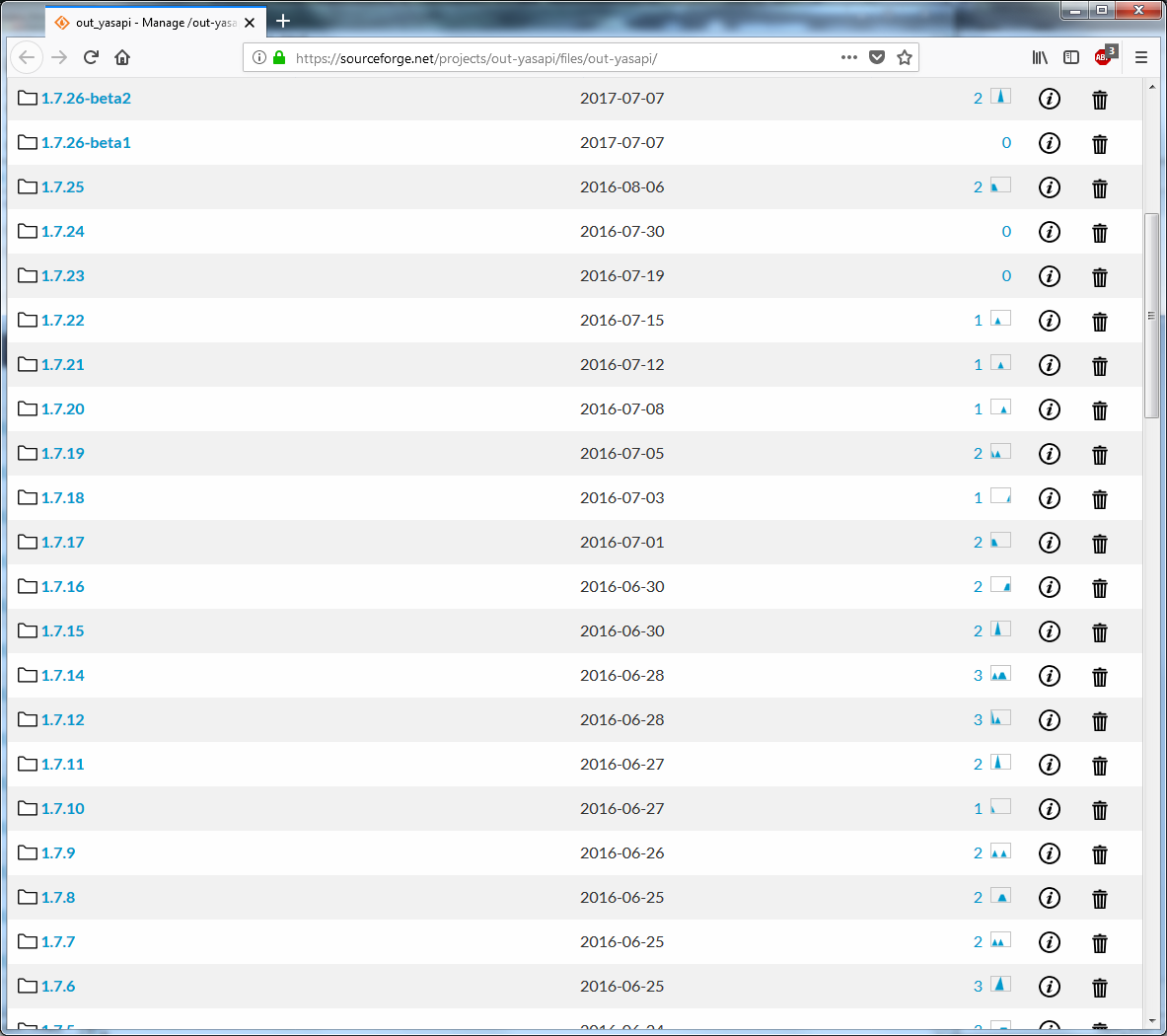
- Who might have an interest in manipulating the download figures (e.g. by
running a background job on low frequency performing automatic downloads) in
favour of the (outdated) pre 2.0+ versions?
- Update 2019-02-03: We're able to
narrow
the irregularity
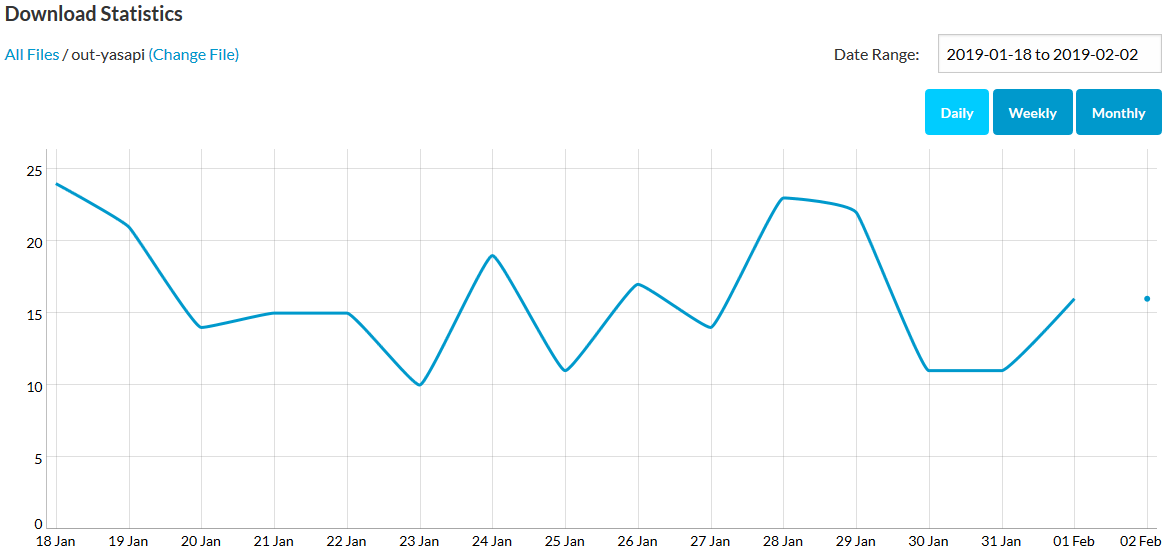
and sharply can say that it is made from servers located in
Poland and France (ignoring a small noise floor):
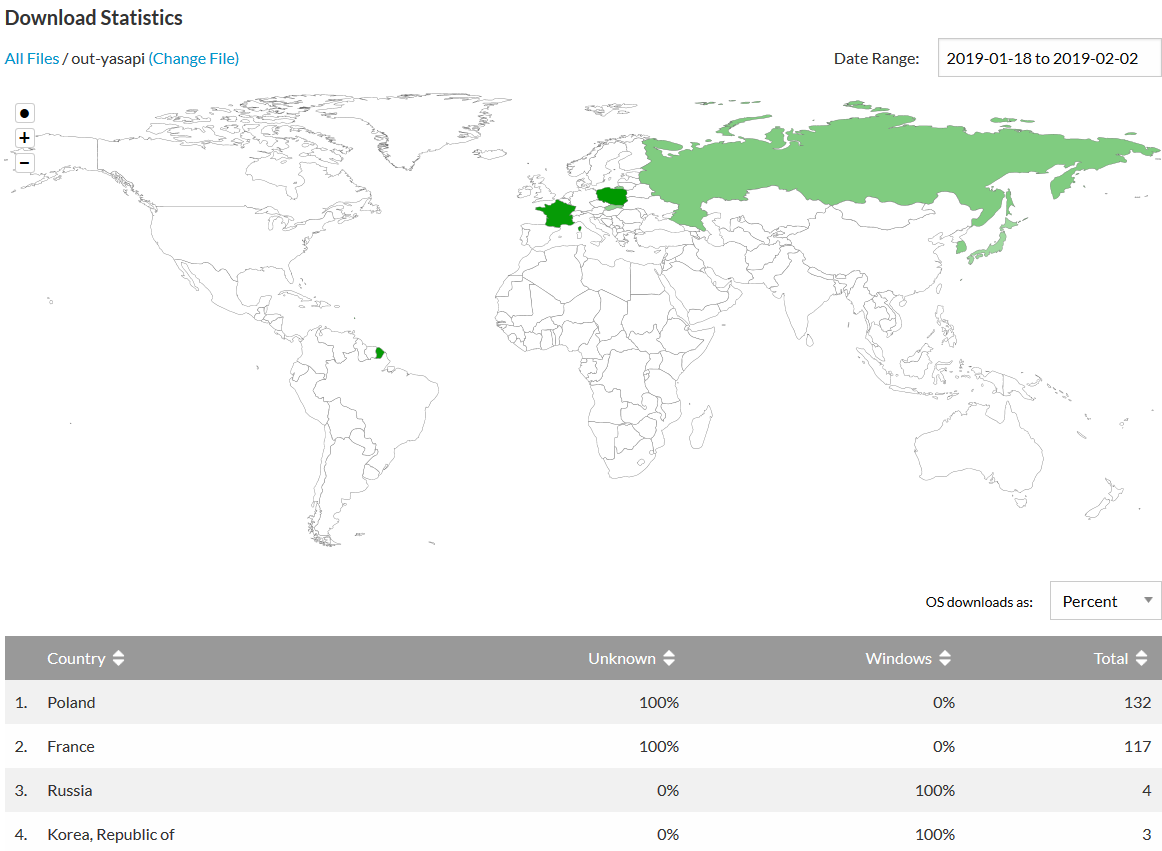
- Update 2019-02-21: A few days after having made public the above anomalie it's slowly
disappearing:
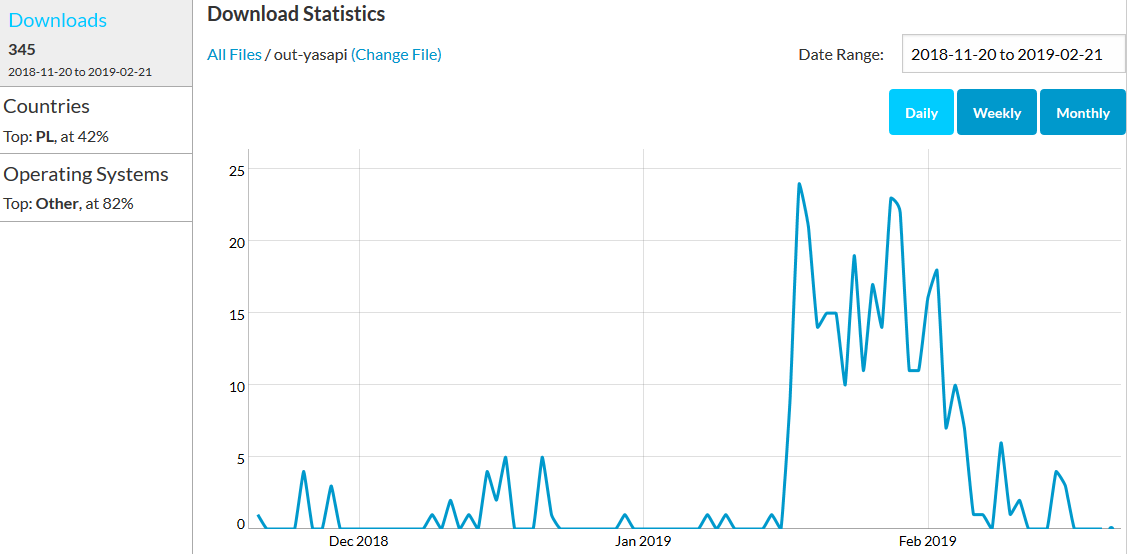
Treffer, versenkt (hit, sunken) 


|
| 2019-02-02 |
2.3.0-β13 |
Fixed the default setting for option Priority of Winamp's Thread when Draining.
|
| 2019-01-14 |
2.3.0-β12 |
Introduced some new or altered, respectively,
snake oil
options:
- Introduced an option for increasing the (audio) renderer thread's
priority. Might be useful for stabilizing audio output when in lowest
latency double buffered mode and in parallel e.g. browsing
the internet. Switching to Above Normal might be sufficient
to avoid any disturbtion:
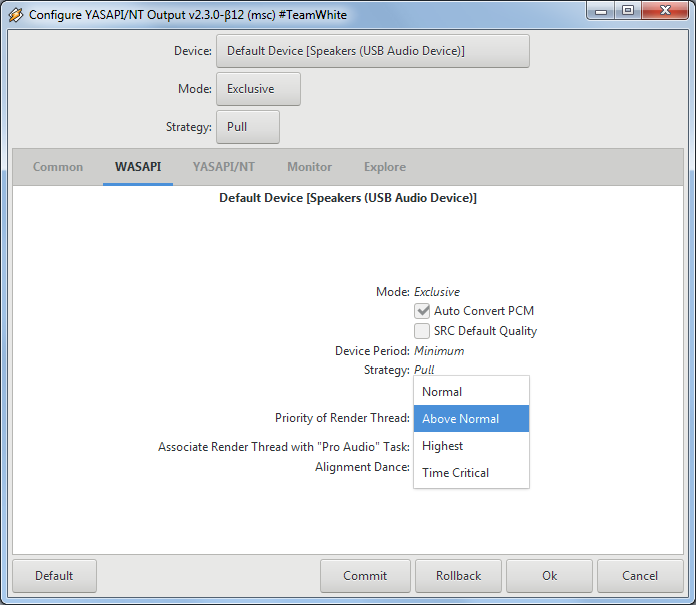
- Replaced the Priority Boost option (indeed nothing other than
snake oil) by two options for temporarily (i.e. when draining)
- increasing the priority of YASAPI/NT's (audio) renderer
thread (it's ignored if chosen not higher than the option described
above), and
- decreasing the priority of Winamp's thread:
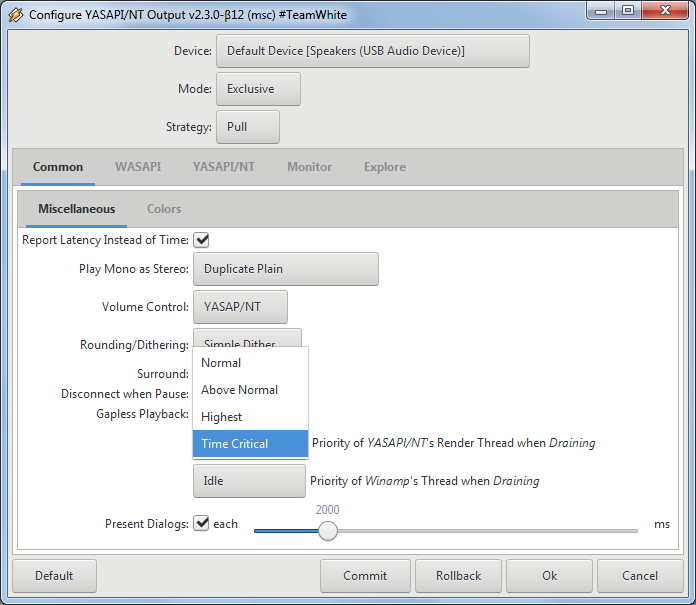
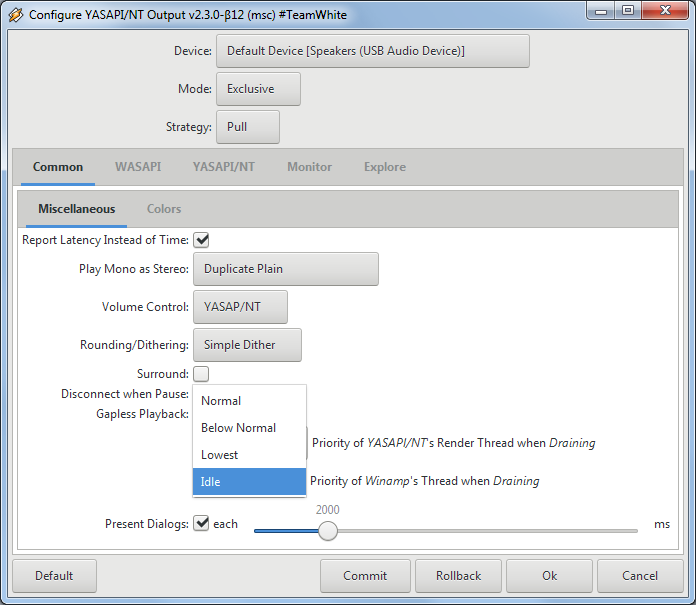
- In case you're using this plug-in in conjunction with our
FFSoX
input plug-in you might further improve
audio stability by decreasing FFSoX's
video renderer thread prirority (since
FFSoX

- Why we're trying to sell those snake oil?
- As
already pointed out
on our system from time to time we observe
kinda stuttering at the end of tracks when in lowest latency
double buffered mode.
- It might appear in gapless mode mostly with
video tracks but isn't constrained to it.
- Our hypothethis is that it is due to
avformat_open_input
called by
FFSoX's
play
method from within Winamp's thread
(in gapless mode might already open the next track when
in parallel still draining the previous track from within
FFSoX's
audio render thread.)
- We're trying to fight this unwanted behaviour by
- improving the audio renderer thread prority in general,
- boosting the audio renderer thread prority when draining
(i.e. at the end of a track),
- lowering Winamp's thread (from where
avformat_open_input
is called) prority also when draining, and
- lowering the video renderer thread prority in general.
- We're on a somewhat outdated 2008 i7 Windows 7 system
(upgraded from Vista.)
It might be that a more decent system has improved thread scheduling and
doesn't stutter at all.

|
| 2019-01-10 |
2.3.0-β11 |
- In a lot of cases simplified communications between engine client
and engine server.
- Got rid of engine client Open state.
- Introduced engine server Render state:
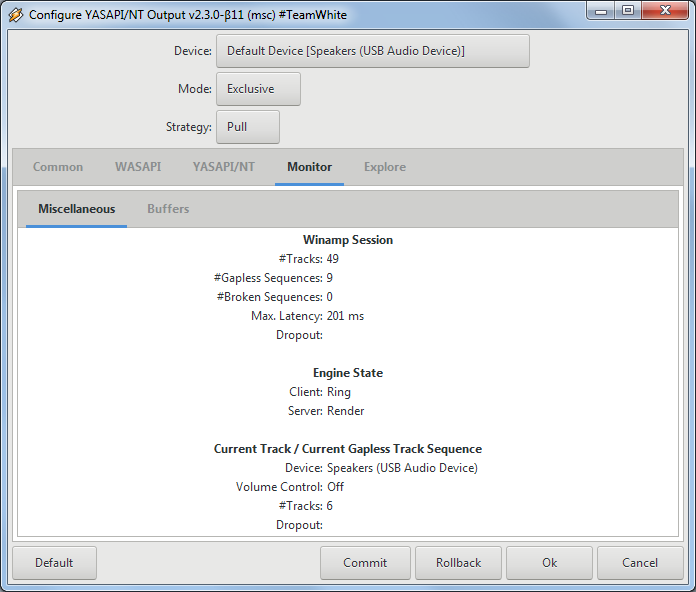
- Various fixes (e.g. the counter of Broken Sequences hadn't
worked as expected: from time to time it might happen that the number of audio
frames cached in YASAPI/NT's buffer is not sufficient to bridge
the gap between tracks ‐ the sequence is broken; with this β-release
the counter should be fixed.)
|
| 2019-01-06 |
2.3.0-β10 |
Some special care must be given to some input plug-ins
writing variable size packets to the output plug-in
(notably "in_mp3".)
We've overlooked to migrate this feature from
v2.2.0-β5
to
v2.3.0-β1.
It's corrected with this β-release.
|
| 2018-12-31 |
|
- Lovely Parasite
 , may we remind you on your promise? , may we remind you on your promise?
- Is that all???

- Erreicht den Hof mit Mühe und Not;
In seinen Armen das Kind war tot.
He reaches his courtyard with toil and with dread, –
The child in his arms finds he motionless, dead.
Johann Wolfgang von Goethe:
Erlkönig
- Not reached yet, surprise, surprise: "the public WACUP preview build
is now aimed for the 1st or 2nd"




- Lovely Parasite
 (the future of Winamp (the future of Winamp 

 ),
guess what? We're tired of waiting. ),
guess what? We're tired of waiting.
- Update 19-01-03: The Lovely Parasite
 finally has shipped its effort.
We've given it a try: finally has shipped its effort.
We've given it a try:
- First impression: Trying to install in portable mode (on a system
partition) crashes.
- It still comes with a stolen version of this plugin
(cf. here and
here. BTW: That's
the only innovation since ages regarding
Winamp's core functionality: audio reproduction.)
The plug-in's crash
seems to be "fixed" just cosmetically: double buffered
mode now simply does not work (without notice.)
- Summary: This is a "product" nobody needs. Nothing other than GUI gimmicks
without any benefit
we had to wait for about three years


 The future of Winamp
The future of Winamp 


- Because we don't want to further honor the Parasite
we've decided to stop commenting on it because
we feel that the ones really interested in WASAPI will find
their way to this page anyway and will not support the
Parasite's effort just because of WASAPI.
- Thanks again
to the talented engineers at
Nullsoft
who had designed already by the late nineties an
API
to Winamp still open enough these days for low-latency audio,
and the engineers at
Microsoft
for crafting
WASAPI.
- Update 19-01-05: How does it go that the Parasite's
effort (technically nothing other than a wrapper to an outdated
Winamp) is hyped by some
MSM
as soon as it appeares (delayed by half a year according to the
Parasite's primary announcement)?
Why the Parasite got stuck to an outdated Winamp
and does not upgrade to a decent version?
Think about it!
(Hint to the latter:
Even Herrschaftswissen
is getting outdated when not getting refreshed


 ) )
- Update 19-01-19: As of today there's another
Lovely Parasite's
 victim:
Otachan
who made the source code of his famous
out_asio
plug-in publicly available: victim:
Otachan
who made the source code of his famous
out_asio
plug-in publicly available:


- Update 19-05-23: As an answer to a
post
hyping the Parasite
as the The future of Winamp


 a
message
appeared on the WA-forum perfectly nailing down what's going on there: a
message
appeared on the WA-forum perfectly nailing down what's going on there:

- Update 19-05-30: Those
SJWs
really
believe


 they're the good ones they're the good ones

where indeed they're nothing other than crypto-communist parasites, e.g.
radio presenter and general purpose nerd:
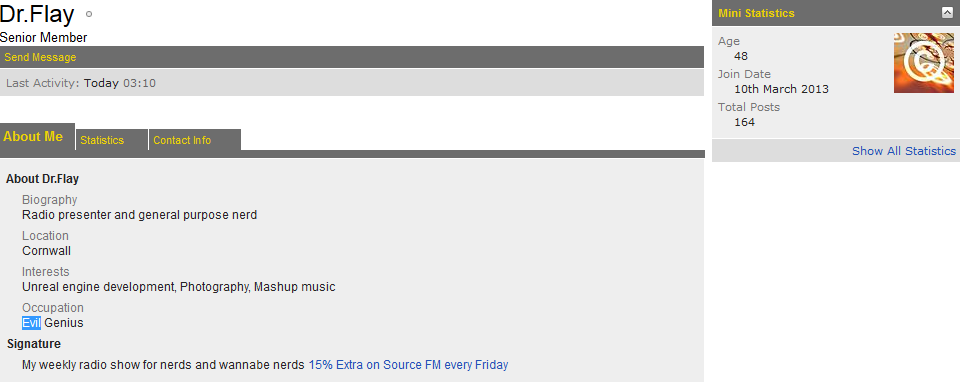
Please note what this particular idiotic SJW is letting us know about
his occupation: Evil Genius.
MWAHAHAHAhahahahahaaaaaaa. . aaa.aaa.aa...a...a.a
*cough cough cough*
|
| 2018-12-30 |
2.3.0-β9 |
- Inserted a group Engine State on the Configuration
dialog's Monitor page. Because it made the dialog by far
to large this particular page was broken up into a
Notebook
control:

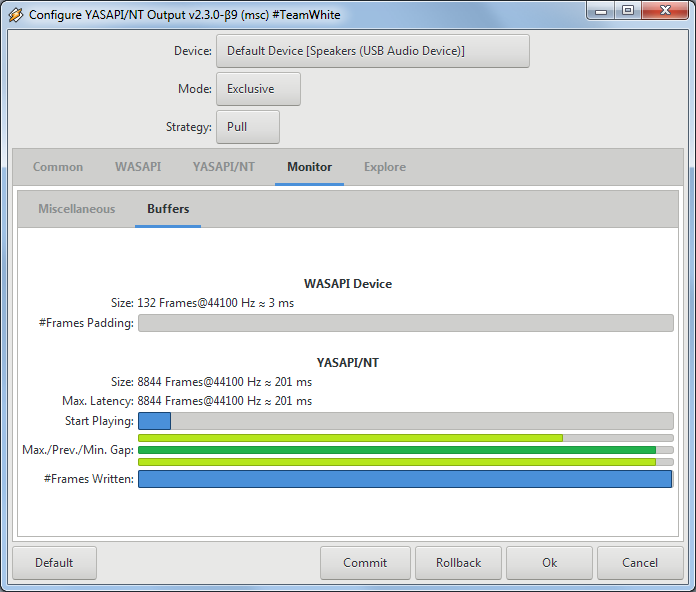
- Did similar with the Common page.
- Still struggeling with some instabilities. Hopefully it's getting smoother now!
- Needs
v181225-1111
of the GTK Runtime upgrading
libatk-1.0-0.dll,
libcairo-2.dll,
libcairo-gobject-2.dll,
libdatrie-1.dll,
libepoxy-0.dll,
libexpat-1.dll,
libfontconfig-1.dll,
libfribidi-0.dll,
libgcc_s_dw2-1.dll,
libgdk_pixbuf-2.0-0.dll,
libgio-2.0-0.dll,
libgmodule-2.0-0.dll,
libgraphite2.dll,
libharfbuzz-0.dll,
libintl-8.dll,
libpango-1.0-0.dll,
libpangocairo-1.0-0.dll,
libpangoft2-1.0-0.dll,
libpangowin32-1.0-0.dll,
libpixman-1-0.dll,
libpng16-16.dll,
libstdc++-6.dll,
libthai-0.dll,
libwinpthread-1.dll, and
zlib1.dll
(bundled with the respective installers.)
|
| 2018-12-18 |
2.3.0-β8 |
- Slighly changed the semantics of the Priority Boost option:
attached it to YASAPI/NT's Draining phase which
in allmost all cases is equivalent to former Close to Open.
- Visually moved the Priority Boost option close to the
Gapless Playback option and let it appear a sub-option to
the latter (which indeed it is):

- In case you're using this output plug-in in conjunction with the
FFSoX
input plugin you should upgrade to
FFSoX v0.5.1.
|
| 2018-12-13 |
2.3.0-β7 |
Next try:
- We have to solve a real life problem (not a problem from a text book):
How to get rid of stuttering at the end of gaplessly played tracks?
- We have already a promising
hypothethis
on what might cause that nasty stuttering.
- We did some experiments in order to validate the
hypothethis
by measuring the time interval between events fired by the respective
Event Object
(by means of the
GetSystemTimeAsFileTime
function) and found that they might correspond to buffer sizes by far exceeding the size of
WASAPI's buffer.
- We searched the whole internet and finally found the promising looking function
SetProcessPriorityBoost:

- Who knows the whole Windows API? Of course, we're not.
That's one of this project's targets: to learn something.
|
| 2018-12-13 |
2.3.0-β6 |
Next try:
- We have to solve a real life problem (not a problem from a text book):
How to get rid of stuttering at the end of gaplessly played tracks?
- We have already a promising
hypothethis
on what might cause that nasty stuttering.
- We did some experiments in order to validate the
hypothethis
by measuring the time interval between events fired by the respective
Event Object
(by means of the
GetSystemTimeAsFileTime
function) and found that they might correspond to buffer sizes by far exceeding the size of
WASAPI's buffer.
- We searched the whole internet and finally found the promising looking function
SetProcessPriorityBoost:

- Who knows the whole Windows API? Of course, we're not.
That's one of this project's targets: to learn something.
|
| 2018-12-12 |
2.3.0-β5 |
- With gapless playback and double bufferd mode on
our system we observed the following strange behaviour
(especially with live tracks played with the
FFSoX
input plug-in which should end apruptly during applause):
- At the end of such a track from time to time there is kinda stuttering.
- Finally we had the idea the cause for this strange behaviour might be heavy load during the
avformat_close_input/avformat_open_input
operations (especially the latter one.) Too heavy for this plug-in's
render thread to continue undisturbed, i.e. firing the respective
Event Object
might come at a time when re-filling
WASAPI's render buffer
is overdue (another cause for dropouts
in double buffered mode we don't have any means to count.)
- Assuming the above theory is true the responsibility to solve
the above issue is, of course, the input plug-in. Anyway, for experimental
reasons we provide a solution which should be valid for any input plug-in
following the protocol known from the
Nulsoft example for an input plug-in:
- Example code for the input plug-in's stop method:
- Close
the output plug-in.
- Close
the respective resource (corresponds to calling
avformat_close_input).
- Example code for the input plug-in's play method:
- Open
the respective resource (corresponds to calling
avformat_open_input).
- Open
the output plug-in.
- We assume that both, the stop
as well as the play, methods are
called from the same core Winamp thread.
- This opens the door for manipulating the core Winamp
thread's priority when the input plug-in goes from
closing
to
opening
the output plug-in from within the output plug-in by means of the
SetThreadPriority
method, i.e. manipulating the thread's priority (i.e. lowering it) during
close
and restoring it during
open when playing back gaplessly.
(Please note that the resource intensive call to
avformat_open_input
while still playing back only happens when playing back
gaplessly.):

- Please note that this is an experimental option we're not fully satisfied with.
- You might remember discussing the
final playback cycle.
Meanwhile we had another look at the
example
provided by Microsoft.
This β-release uses an approach correponding to a
slightly modified version
of the example.
Indeed, we don't understand why Microsoft prefers
sleeping
in favour of (more naturally)
waiting
for the next event.
- Still struggling with the already
mentioned
instability during skip.
Hopefully found the root cause (there where unwanted
EnterCriticalSection/LeaveCriticalSection
pairs when updating the GUI)
and fixed it.
|
| 2018-12-08 |
2.3.0-β4 |
- Introduced integration with the
FFSoX Player
input plug-in:
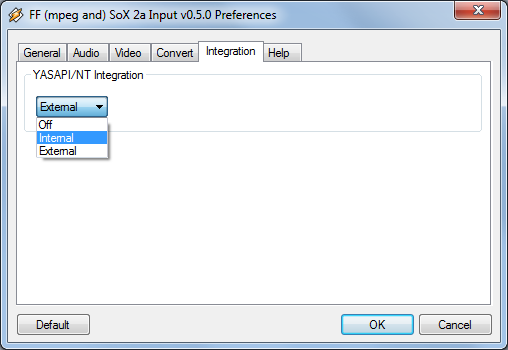
- Starting with this β-release YASAPI/NT
exports an
interface
each input plug-in is invited to use in interacting
with the output plug-in (of course we know that nobody
other then us will do


 ). ).
- The advantage of this interface is that an input plug-in
is not required to wait for an arbitrary time when not enough
space is avalaible for writing (cf.
busy waiting
in the Nullsoft example for an input plug-in.)
Instead the output plug-in waits inside the interface's
Write()
mehod on an
event object
until the requested space is available.
- In an analog way
busy waiting
for the end of track has to be substituted by a call
to the interface's
EndOfTrack()
method.
- Unfortunately, if you're using gapless playback
the latency is bounded from below by the amount of samples
needed to be cached in order to bridge the gap from one track
to the next. May be we can relax this by furter working on
the
FFSoX Player
and
Yet Another Shuffle
plug-ins.
Anyway, you may observe at least that buffer fluctuations dramatically
reduce until close to vanishing (by watching the respective monitor control)
when trying one after the other:
integration off,
integration internal, and
integration external.
|
| 2018-12-06 |
2.3.0-β3 |
- Finally enabled gapless playback.
- Introduced a control for monitoring the maximun, previous, and minimum
bridged gap, resepectively, between tracks of a gapless sequence:

- (Hopefully) fixed an instability when skipping (a possible
deadlock.)
|
| 2018-12-01 |
2.3.0-β1 |
- As announced with v2.2.0-β5 we're back
again with a new release based on a modified architecture.
- While working on the documentation
(now frozen into v0.1) we came to the conclusion that we should
split class WASAPI Engine into it's Client/Producer
and Server/Consumer parts.
- While at it we discovered that it would be advantageous to factor out from
both a common functionality into something we called
Finite State Machine (FSM).
It's not the most general FSM we can imagine because each of our states has
the special property of having exactly one incoming edge and exactly one outgoing
edge (you may have noticed this from documentation v0.1).
Hence our FSM is not able to take into account any history.
- The implementation of our states is along the lines of
a preprocessor pattern described to some extend
in section "Printing enum values as strings"
here.
- Then we had the idea that we could apply the same technique to the GTK thread.
- Finally we had the idea that on user request we could create another thread
based on the exact same pattern bringing the dialogs in front of the visualizaton
with a certain frequeny replacing the per dialog position options:

- Our next plans are
- v2.3.0-β2: gapless playback, and
- v2.3.0-β3: integration with the
FFSoX player
input plug-in.
|
| 2018-11-29 |
|
- A series of messages appearing on the WA forum made us aware that Radionomy
might have silently(!) retract
Winamp 5.8 (cf.
here,
here,
here,
here,
here,
here,
here, and
here):
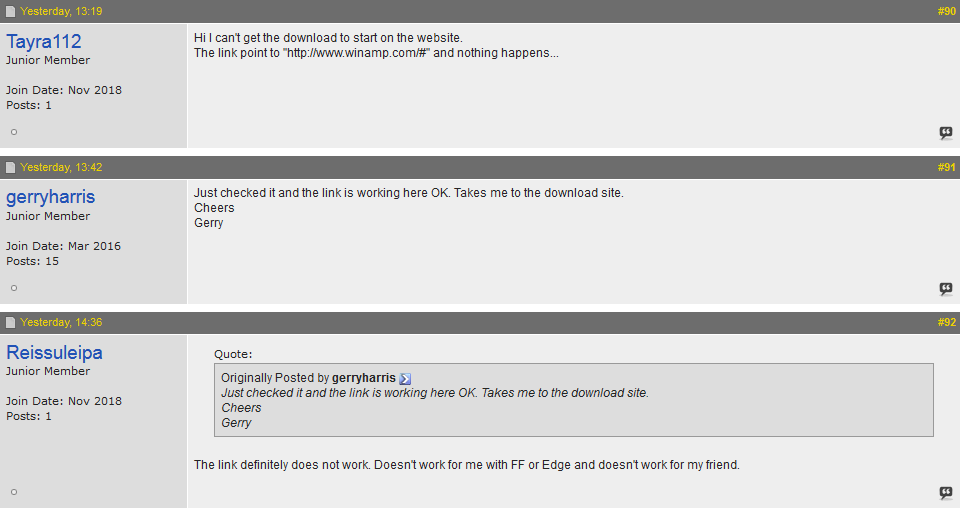
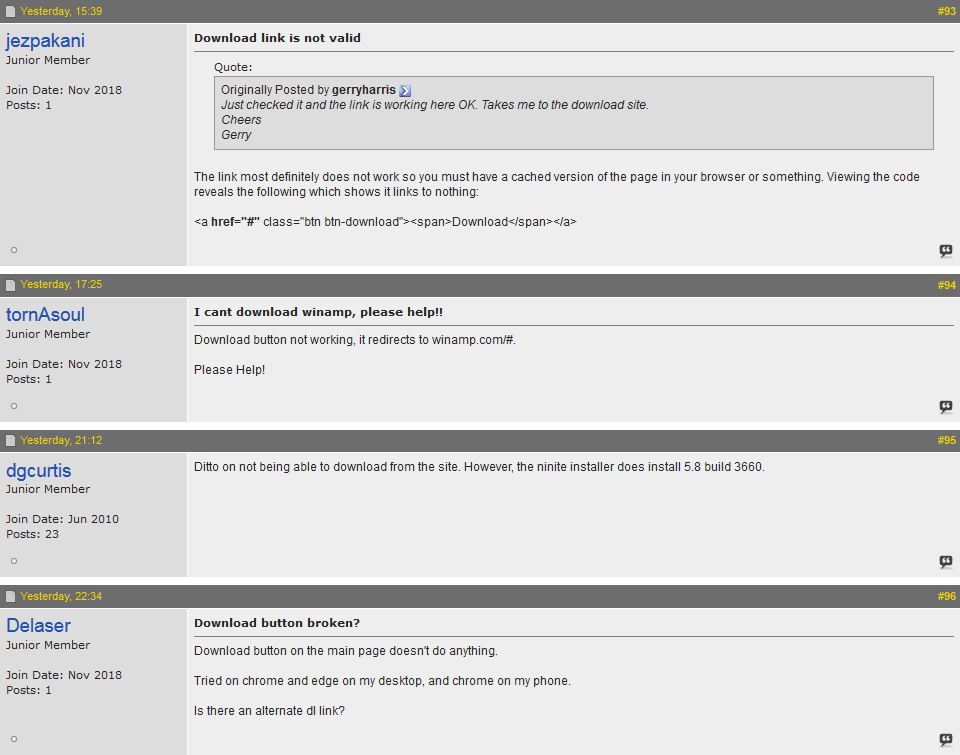

- We confirm that this really is the case (cf. the lower left corner of
the following image displaying the link from where the mouse is over;
and in case the mouse is over the download button it is not pointing
to any download but to the top of the current page):
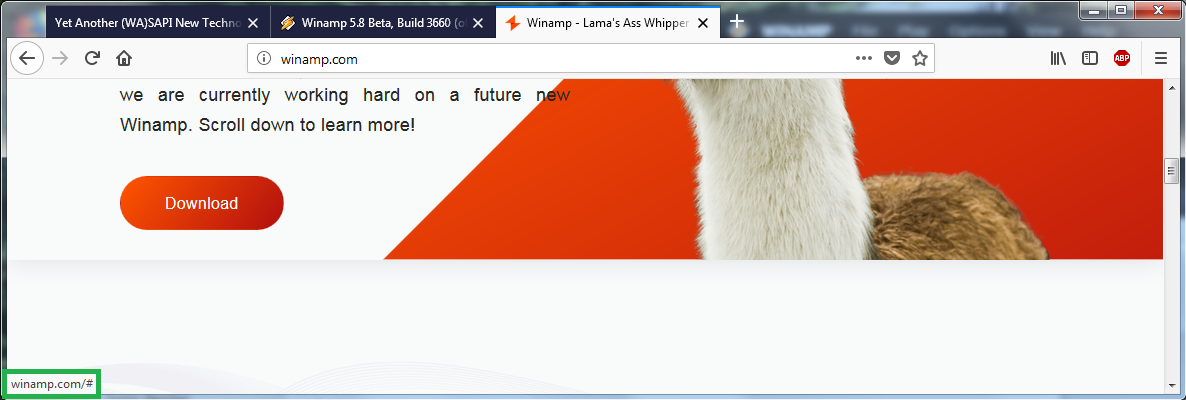
- Cf. also the corresponding anchestor's href attribute:

- We don't know whether this has to do with Benski's
WASAPI output being nothing other than rubbish.
Anyway, this gives us the perfect opportunity to point out that the history of Winamp
seems to us the perfect model to the history of (western) societie's governements:
The once leading edge technology company Nullsoft during the years has gotten
into the hands of people appearing to us just like a bunch of betrayers (especially
not respecting intellectual property) just like the (western) societie's governements.
To name a few w.r.t. Winamp:
- the Lovely Parasite
 (cf. here), (cf. here),
- the Senior Director of Engineering at iHeartRadio,
Ben Allison
(cf. here)
aka Benski,
(cf. here),
- the WA forums's moderator Pawel (cf. here
- update 2018-12-17 -
and here),
- the self-proclaimed Humanitarian
(cf. here


 )
and Radionomy employe DJ Egg
(cf. here) )
and Radionomy employe DJ Egg
(cf. here)
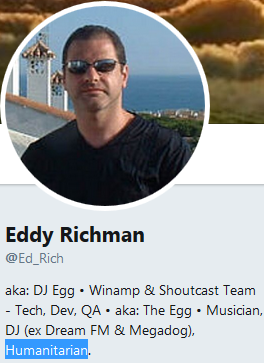
- and more;
w.r.t. (western) societies cf. e.g.
here,
here,
and (update 2018-11-30) especially
here
(anyway, we miss at least a clear statement regarding 9/11 in order to fully
believe in this. Update 2018-12-10: You might read
this.)
- Finally (we noticed it in the evening) Radionomy has brought back
the download link. The least one can say regarding this episode is that it does
not look very professional



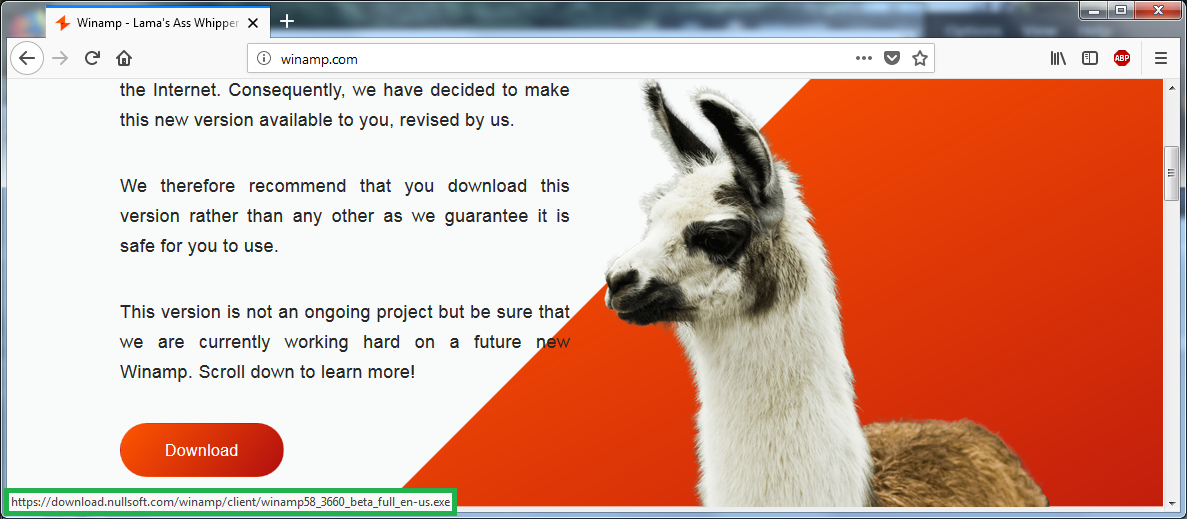
|
| 2018-10-24 |
|




Anyway, we have a similar problem: This plug-in might crash with Winamp v5.8
when unpause. Hopefully this will be fixed with the next version.
Update 2018-10-25: This was due to a feature of the
FF (mpeg and) SoX 2a Input plug-in
not published yet.
|
| 2018-10-22 |
|
- The Lovely Parasite
 has fresh promises has fresh promises 



- And of course, he wants your
shekels just based on empty promises:

|
| 2018-10-20 |
2.2.0-β5 |
- Another β-release as a direct consequence of working on the
documentation.
- Got rid of class Request including enumeration ERequest.
- Got rid of HANDLE hEot.
- Renamed state eEngineEot into eEngineDrainingDoubleBuffered and changed
it's semantics accordingly.
- Fixed a subtle synchronization issue
(i.e. missing case eEngineBase.
Note: In case the link is not working as expected open it using Open Link in New Tab.)
- The current state of the documentation is frozen into v0.1.
- This β-release might mark the end of the v2.2.x-releases
because we came to the conclusion that it's best to split class
Engine
into it's Client/Producer
and Server/Consumer parts.
- We'll might be back some day with v2.3.0-β1 hopefully
reproducing what we have today.
|
| 2018-10-19 |
|
- Radionomy has an official
Winamp v5.8
out:
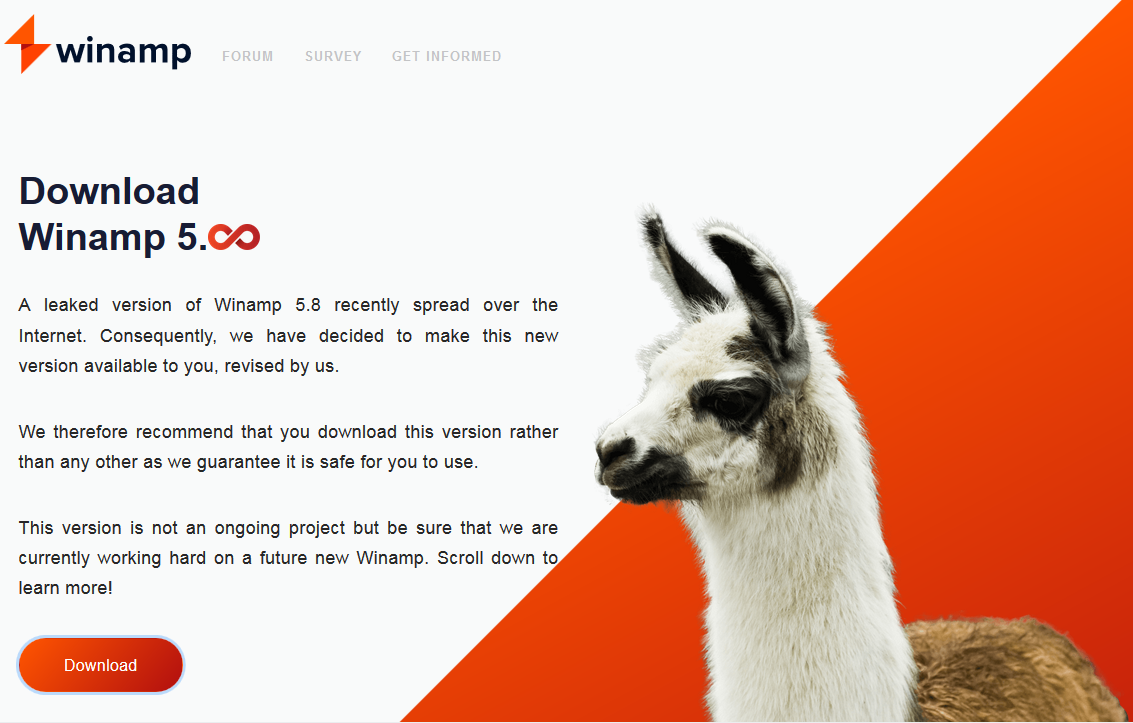
- It is equipped with a Nullsoft WASAPI Output plug-in:
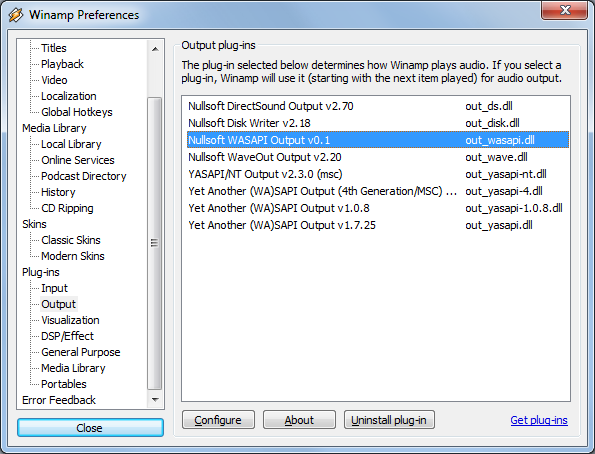
- The author of the plug-in is one out of the talented Nullsoft
engineers (Ben Allison aka
Benski):
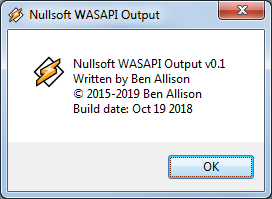
- Unfortunately, there seems no Configuration dialog.
- Too sad, it does not work for us even if we don't operate
an esoteric device (cf. here.)
There's not the slightest sound coming through.
- Update 2018-10-20: For us
Benski's WASAPI Output
not only does not work but it also mutes the standard
Nullsoft DirectSound Output
as well as YASAPI/NT Output's two shared modes.
Finally we figured that it's
possible to re-animate Nullsoft DirectSound Output
as well as YASAPI/NT Output's two shared modes
but not Benski's WASAPI Output
by in-between using Nullsoft WaveOut Output.
Benski, what have you done?
Anyway, we really like the new Big Bento Modern skin



- Moreover, there's no hint in which mode Benski's WASAPI Output
is operated, i.e. whether in exclusive/pulled (double buffered) mode,
or in exclusive/pushed mode,
or in shared/pulled mode,
or in shared/pushed mode.
Just WASAPI.
(Update 2018-10-20: What is described above and what appears
to us as a severe bug of Benski's WASAPI Output is a strong hint
towards it is attempted just to operate in one out of the shared
modes, i.e. in a mode just eqivalent to DirectSound.)
Having Winamp labelled WASAPI seems sufficient for marketing.
- Update 2018-10-20: The Winamp forum announces Benski's effort
at position one marked as w.i.p.
(we read work in progress):

They've forgotten to mention that it might not work at all and that trying it
might break DirectSound Output.
- Sorry Benski, it was a nice try. But there's still
a lot of work just around the corner. Update 2018-10-21: Possibly not what a
Senior Director of Engineering is looking for (cf. also
here)



- Update 2018-11-23: Because on some systems
Bensk's effort does it's job at least to some extend
we'd like to provide some information on our system (we confirm that we
can bring Benski's effort to life also by moving the volume slider):
- We're on Windows 7.
- The driver seems to be provided by Microsoft, i.e. is standard:


- The product itself is an inexpensive one from
Amazon.
- Update 2018-11-24: Several messages appearing on the WA forum meanwhile
confirm that we're not spooky and that Benskis's effort is
indeed nothing other than rubbish (cf.
here,
here,
here
and
here):
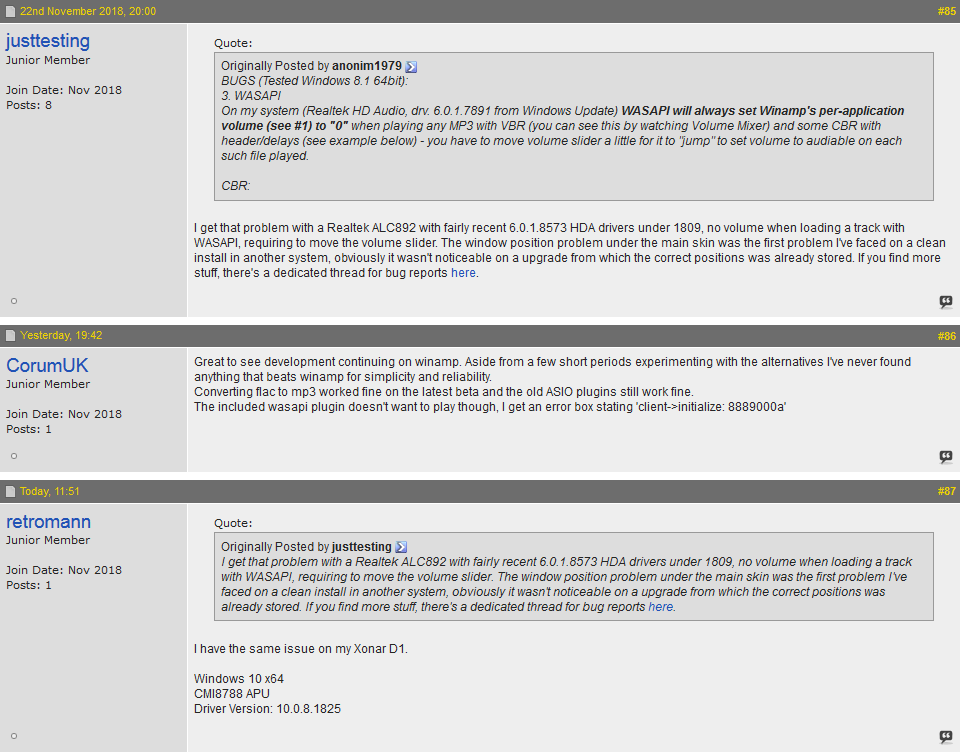
- The best of all: the Lovely Parasite
 is whining is whining 


|
| 2018-10-17 |
|
Sometimes the Lovely Parasite  got something right got something right 
|
| 2018-09-28 |
2.2.0-β4 |
- Had a second look at the Microsoft text-book example on rendering
Exclusive-Mode Streams
while working on the
documentation
and ask ourselves how we came to the impression that an extra half-cycle
has to be added when indeed it is a full cycle needed to drain the
WASAPI buffer.
- Finally had an idea on how the usage of the (somehow artifical and
in-accurate at least on the required time-scale)
Waitable Timer Object
could be avoided at all: We could add an additional cycle with silence
and when the time comes to play this cached cycle we simply end playback.
- As a result there are now two options for adding the additional cycle when in
double buffered mode (i.e. when in exclusive pulled mode):

- Re-structured some of the GUI-code (e.g. Droput is counted now
in audio fames and ms, respectively.)
- Improved the (still draft) documentation.
|
| 2018-09-28 |
|
The GTK runtime's v180928-1502
providing updated versions of
gspawn-win32-helper.exe,
gspawn-win32-helper-console.exe,
libgdk-3-0.dll,
libglib-2.0-0.dll,
libgobject-2.0-0.dll, and
libgtk-3-0.dll
is
available.
|
| 2018-09-19 |
|
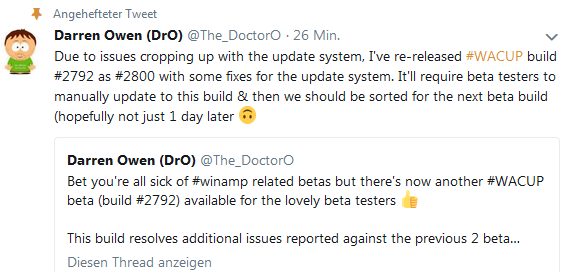
A fix to correct the fix to correct the
fix
just within five days.
All just in order to entertain the lovely beta testers



Note: Don't get us wrong. We know what it means to
manage complex software systems. Anyway, we don't hype ourselfs
nor being hyped by somebody else as the future of Winamp
(what indeed needs some kind of organization instead a single
individuum) when in reality just
stealing away somebody else's work:

Of course, the Lovely Parasite  is a Good Guy®. We don't have
the slightest doubt. But believe us, we really don't want belong to
(((those))) good guys is a Good Guy®. We don't have
the slightest doubt. But believe us, we really don't want belong to
(((those))) good guys 


|
| 2018-09-16 |
2.2.0-β3 |
We just observed that time reporting was completely broken when the
Report Latency Instead of Time optimization was not chosen
(possibly already for a longer time.) This β-release fixes the oddity.
|
| 2018-09-16 |
2.2.0-β2 |
- This β-release should be without any effect to the plug-in's
functionality.
- We re-structured the build-process by means of the
m4 macro processor
in order to get rid of allmost all YASAPI prefixed
C preprocessor
symbols from the published source code.
- The aim of this β-release is to some extend make sure that everything
has survived this transformation.
- Please have in mind the above note.
- Got rid of state eEngineDrainigFinal.
- Added a (missing) final half cycle to double buffered playback
(cf. the usage of a
Waitebale Timer Object
at the Microsoft example for rendering
Exclusive-Mode Streams.)
- The latter two points are direct consequences of thinking twice
while working on the
documentation.
|
| 2018-09-14 |
|
Meanwhile the Lovely Parasite  confirms that its
announcement from 2018-09-05
was nothing other than fake news (due to its
"creative" approach to reality confirms that its
announcement from 2018-09-05
was nothing other than fake news (due to its
"creative" approach to reality


 ): ):

We still have doubts that build #2770 really exitsts
available to somebody other than the Lovely Parasite  itself because
there's still no corresponding entry at the Winamp Ramblings blog
(as it usual is the case): itself because
there's still no corresponding entry at the Winamp Ramblings blog
(as it usual is the case):

Please note that according to its own words since november last year
the Lovely Parasite  has crafted nothing other than bug fixes has crafted nothing other than bug fixes 


|
| 2018-09-08 |
|
Version 180908-1913 of the GTK runtime providing ugraded versions of
gspawn-win32-helper.exe, gspawn-win32-helper-console.exe,
libgdk-3-0.dll, libglib-2.0-0.dll, libgobject-2.0-0.dll, and
libgtk-3-0.dll is
available.
|
| 2018-09-06 |
|
That's exactly how naïve believers look like:
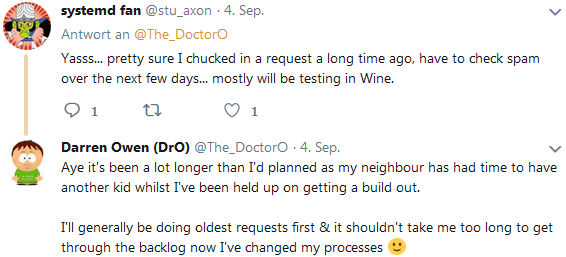
Kinda funny



|
| 2018-09-05 |
|

Lovely Parasite  , this announcement is a
vaporware
par excellence: No download link available not even for the
registered naïve "lovely beta testers" and
no corresponding entry to the Winamp Ramblings blog.
Instead: "The update flag will
be set in a few days & all beta requests
will be followed up over the next few days."
(Cf. also here
and
here.)
As already mentioned, we're still waiting
for the public release announced a long time ago. , this announcement is a
vaporware
par excellence: No download link available not even for the
registered naïve "lovely beta testers" and
no corresponding entry to the Winamp Ramblings blog.
Instead: "The update flag will
be set in a few days & all beta requests
will be followed up over the next few days."
(Cf. also here
and
here.)
As already mentioned, we're still waiting
for the public release announced a long time ago.
BTW: Triggering the Lovely Parasite  is real fun! is real fun!



|
| 2018-09-01 |
|
We're aware that we're not the world's most gifted
software developer. Anyway, we feel that we belong to
#TeamWhite
and hence added the respective hashtag to the above
note.
|
| 2018-08-31 |
|

Lovely Parasite  , we
ment
a public release (according to your annoncements it's
overdue anyway) not just another
vaporware
just available to your naïve registered believers. , we
ment
a public release (according to your annoncements it's
overdue anyway) not just another
vaporware
just available to your naïve registered believers.
BTW: Its "creative" approach to reality along with
its parasitic behaviour and its
greed for shekels
seems an indication
to the Lovely Parasite's  nationality. Anyway, at least
it appears to be strongly influenced by
(((those))). nationality. Anyway, at least
it appears to be strongly influenced by
(((those))).
|
| 2018-08-30 |
|
Loading this site's online version became slower and slower because
we've got lots of images in section
News.
That's why for the online version we introduced incremental loading
of section
News
by means of some technics known from
dynamic HTML
notably
XMLHttpRequest.
The site's previous version is available
here.
|
| 2018-08-26 |
|
Published a
Sequence Diagram.
|
| 2018-08-25 |
|
runtime is
available.
|
| 2018-07-15 |
2.1.0 |
- Allmost the same as
v2.1.0-β6
except some code cleanup.
- Next steps might be:
- v2.2.0-β1 Reorganization of
YASAPI/NT's buffer in order that it better
suits gapless playback.
- v2.2.0-β2 Gapless
playback.
|
| 2018-07-05 |
|
- From the Lovely Parasite's
 Twitter account:
Twitter account:
- As Twitter user Jeremy King puts it
(including another spooky remark by the Lovely Parasite
 ): ):
- Twitter user Daria comments:
- Twitter user J.R. Raith with a fine irony
regarding the Lovely Parasite's
 abilties: abilties:
|
| 2018-06-24 |
2.1.0-β6 |
- Fixed a subtle bug with Dithering.
- Restructured time reporting functions, i.e.
getwrittentime() and getoutputtime().
|
| 2018-06-24 |
|
Version 180620-0644 of the GTK
runtime providing ugraded versions of
libfribidi-0.dll,
libharfbuzz-0.dll, and
libintl-8.dll
is
available.
|
| 2018-06-03 |
2.1.0-β5 |
- Introduced
Dithering:

- You might ask yourself what
Dithering
is:
- First of all: Dithering makes only sense when
reducing bit depth, say from 32 to 24
or 16 bits. Otherwise simply 0-bits will
be padded.
- When throwing away bits you might think a moment on
how doing it. What next comes to mind is Rounding.
- You might view Dithering as a generalized form
of Rounding. When Rounding a constant
value of half of the number of bits to throw away
all set is added before
shifting to the right by the
number of bits to throw away (that way actually
throwing them away.) Dithering
generalizes this approach by not just adding a constant
value but a value over time fluctuating
from 0 to the number of bits to throw away
before shifting to the right. This randomized
version of Rounding is aimed to break interference
pattern known as quantization noise.
- Currently YASAPI/NT implements a simple Dithering
algorithm (without noise shaping) following the
idea sketched at
https://www.kvraudio.com/forum/viewtopic.php?t=132643
under consideration of
http://c-faq.com/lib/randrange.html.
- Please note that this is also
Поднятая целина.
Not a single prior (or hijacked) version of the plug-in is supports
Dithering.
|
| 2018-06-01 |
|
v180531-1449
of the GTK+ runtime have been published. It contains updates
to the following executables and DLLs:
gspawn-win32-helper.exe,
gspawn-win32-helper-console.exe,
libatk-1.0-0.dll,
libepoxy-0.dll,
libgio-2.0-0.dll,
libglib-2.0-0.dll,
libgmodule-2.0-0.dll,
libgobject-2.0-0.dll,
libiconv-2.dll.
|
| 2018-05-27 |
2.1.0-β4 |
- Introduced support of Volume Control for
Exclusive Mode playback due to WASAPI interface
IAudioEndpointVolume
(once scheduled as v2.1.0-β3).
- Interface IAudioEndpointVolume is ab bit more special than
Interface ISimpleAudioVolume because there must be
hardware support for volume control.
- YASPI/NT tests whether there is hardware support for
volume control by means of the
IAudioEndpointVolume::QueryHardwareSupport
method. If not it falls back to it's own software solution
as is illustrated by the following images:
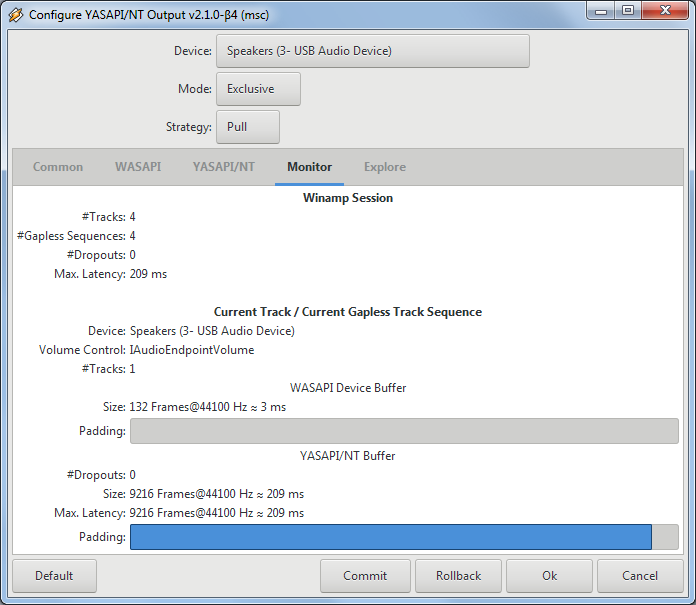
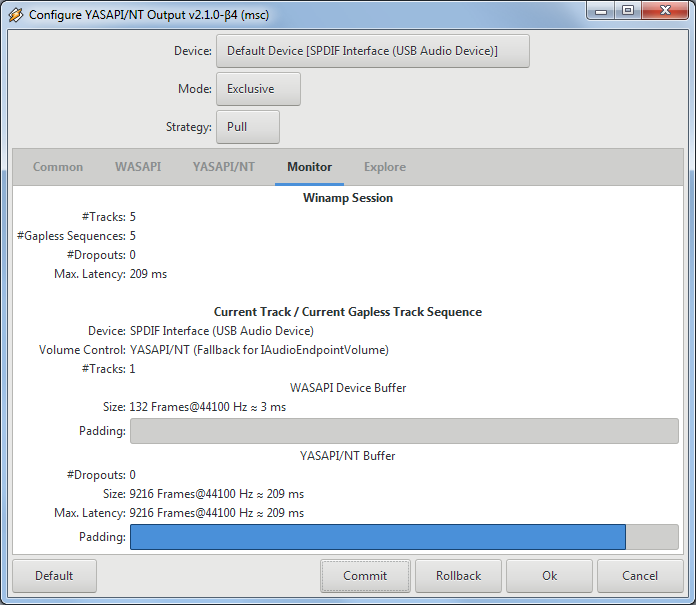
The image on the left hand side shows a device with
hardware support wheras the image on the right hand side
shows one without.
- Please note that this as well is
Поднятая целина.
Not a single prior (or hijacked) version of the plug-in is supporting
WASAPI interface
IAudioEndpointVolume.
|
| 2018-05-20 |
2.1.0-β3 |
- The next regular update once scheduled as
v2.1.0-β2 introducing support of
Volume Control for Shared Mode playback
by means of WASAPI interface
ISimpleAudioVolume.
- Replaced check box Volume Control by a respective
combo box:


The combo box offers the following entries:
- Off corresponds to the former check
box being unchecked, i.e. no Volume Control
at all,
- YASAPI/NT corresponds to the former check
box being checked, i.e. Volume Control by means
of a simple software algorithm provided by YASAPI/NT,
- WASAPI correspons to Volume Control
depending on what is chosen by means of check box Mode, i.e.
- when Shared by means of WASAPI
interface ISimpleAudioVolume,
- when Exclusive potentially (propably with the next
β-release) by means of WASAPI interface
IAudioEndpointVolume
(with this β-release just by the software algorithm provided by
YASAPI/NT).
- What YASAPI/NT really applies is displayed at Monitor page.
- Please note that this is
Поднятая целина.
Not a single prior (or hijacked) version of the plug-in is supporting
WASAPI interface
ISimpleAudioVolume.
|
| 2018-05-18 |
2.1.0-β2 |
- This is an irregular update. Hence no new features.
Just re-compiled with the
new GTK+ runtime v180518-1351
depending now on zlib1.
- Created
NSIS
installers with GTK+ bundled because they might be preferable
for some casual user over dealing with a
second download
and installation.
- BTW: Prior (and most likely as well hijacked)
versions of the plug-in crash when used with Double Buffered
mode, i.e. with Exclusive Pulled mode:

Please note that versions 2.0.0-β1+
have NOTHING IN COMMON with prior (or hijacked) versions
(except part of the brand and of course some ideas). That's
essential YASAPI/NT vs. YASAPI.
|
| 2018-05-13 |
2.1.0-β1 |
- With this β-release check box Volume Control
is enabled:

- When checked, volume control due to a simple algorithm
implemented by YASAPI/NT is enabled (i.e.
no dithering nor accessing WASAPI
interfaces.)
- Different to prior (or hijacked) versions of the plug-in
the algorithm is applied when reading from YASAP/NT's
buffer and writing to WASAPI's buffer. (Prior - or
hijacked - versions of the plug-in did it when writing
to the plug-in's buffer.) You'll immediately notice the
difference: now there's practically no latency when moving
Winamp's volume slider.
- What is chosen by means of Volume Control is reported
on the Monitor page:
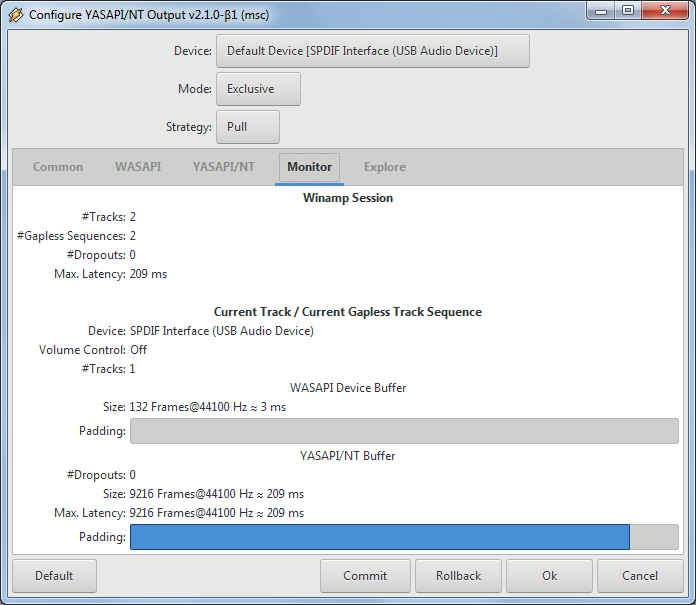
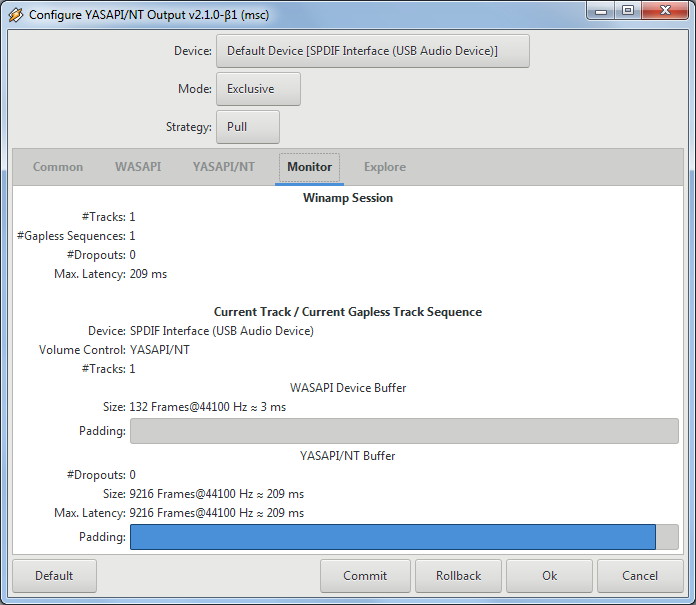
-
The Lovely Parasite
 on his WEB site with time stamp 2016-12-29 02:22
has published an updated version of the Winamp SDK expressing his
Herrschaftswissen
(might be translated by domination knowledge): on his WEB site with time stamp 2016-12-29 02:22
has published an updated version of the Winamp SDK expressing his
Herrschaftswissen
(might be translated by domination knowledge):
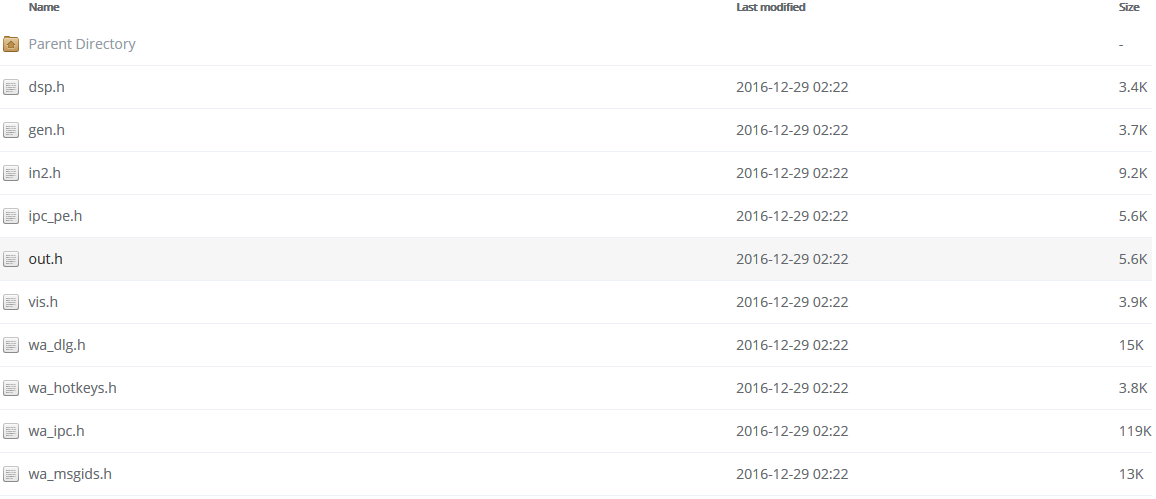
We mention that because from it we've learned something
interesting being valid just for Winamp 5.64+. You might
consider this a prerequisite for this β-release and all what
follows. We'll not going to C-include those header
files but make deliberately use of what we've learned
(starting with this β-release.)
- BTW: We're not certain on whether Winamp's current owner,
Radionomy,
is amused on the Lovely Parasite's
 effort. As it seems way back already
in late 2016 the Lovely Parasite effort. As it seems way back already
in late 2016 the Lovely Parasite  was forced by means of
a legal complaint due to Radionomy to deliver the
following statement
along with changing its effort's URL: was forced by means of
a legal complaint due to Radionomy to deliver the
following statement
along with changing its effort's URL:

|
| 2018-05-09 |
|
Version
180504-1316
of the GTK+ runtime is available.
(No version change visible from the surface but at least an
updated version of libiconv is contained.)
|
| 2018-05-06 |
2.0.0 |
- Essentially the same as v2.0.0-β10
except some minor changes, of course:
- At last minute we've changed writing YASAPI NT to
YASAPI/NT (with a slash). In order to avoid too much
slashes it now reads YASAPI/NT Output v2.0.0 (msc)
or YASAPI/NT Output v2.0.0 (gcc), respectively,
i.e. the compiler used is appended within braces.
- Upgraded from Visual Studio Express 2012 to
Visual Studio Express 2013 resulting in a minor
updated msc version: from 18.00.3201
(cf. below)
to 18.00.40629:

After all we don't use Visual Studio anyway
except two command line tools out of the bunch:
- the C compiler
cl.exe, and
- the library manager
lib.exe.
- Please note that the first of the below mentioned
limitations is already removed,
i.e. format (mono to stereo and bit depth) conversions
are yet available.
- This milestone should provide a basis solid enough for moving on.
- The next milestone will be v2.1.0 Volume Control (cf.
milestones.)
Our goal is not just provide
some simple software solution but also support the
ISimpleAudioVolume
(for Shared Mode playback) and the
IAudioEndpointVolume
(for Exclusive Mode playback) WASAPI interfaces.
- Hence next we'll have the following refined targets:
- v2.1.0-β1: Volume Control by means of
software provided by YASAPI/NT,
- v2.1.0-β2: Volume Control
for Shared Mode playback supporting the WASAPI
ISimpleAudioVolume
interface, and
- v2.1.0-β3: Volume Control
for Exclusive Mode playback supporting the WASAPI
IAudioEndpointVolume
interface.
|
| 2018-05-06 |
|
- Following is the perfect answer to the
question
from the Lovely Parasite's
 forum:
Post (Oct 21, 2017)
taken from the
guru3D forums
makes the essential point (although the guy seem to mix up
WASAPI with ASIO and that one should fall back
on Shared Mode only if Exclusive Mode for
some reason does not work. Only in case Shared
Mode is used with the same format configured with
Control Panel → Hardware and Sound → Sound
→ Playback → Device → Properties there should
be no difference to Exclusive Mode): forum:
Post (Oct 21, 2017)
taken from the
guru3D forums
makes the essential point (although the guy seem to mix up
WASAPI with ASIO and that one should fall back
on Shared Mode only if Exclusive Mode for
some reason does not work. Only in case Shared
Mode is used with the same format configured with
Control Panel → Hardware and Sound → Sound
→ Playback → Device → Properties there should
be no difference to Exclusive Mode):
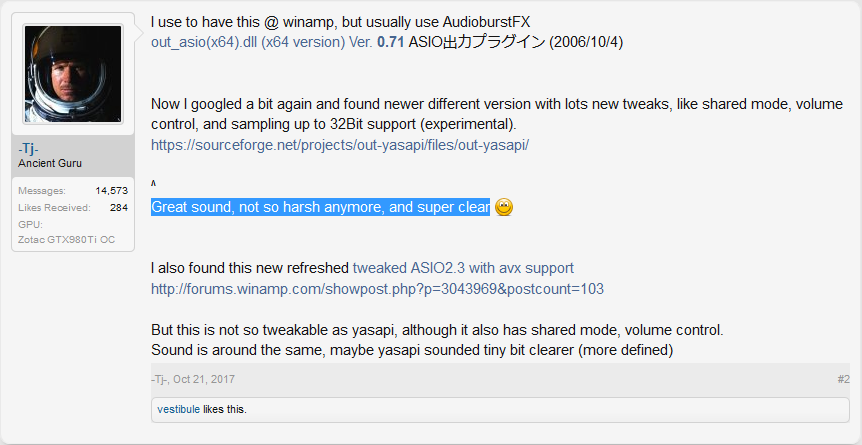
This guy apart each theory experienced the huge
potential w.r.t audio reproduction each PC has due to
WASAPI.
The only thing YASAPI/NT adds is to make this potential
available to Winamp users.
- Tip: We're digitally connecting
our PC to the amplifier by using an inexpensive WASAPI
enabled USB to coaxial/TOS adapter and that way using the quality
DAC
build-in to our amplifier in order to convert from the digital
to the analog domain. (We've ripped our CD collection into
loudenss normalized
FLACs
- most importantly a
lossess format
- and like listening to it in Winamp
random mode.)
|
| 2018-05-05 |
|
Version
180503-0953
of the GTK+ runtime is available. (No version change visible from the
surface but at least an updated version of libcairo is contained.)
|
| 2018-04-30 |
|
Uploaded version
180426-0807
of the GTK+ runtime lifting libgtk's version from 3.22.29
to 3.22.30 (cf. v180412-1003):
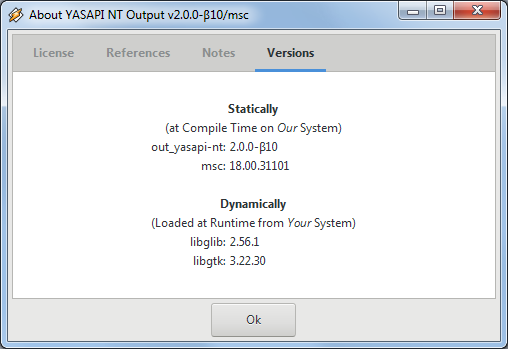
|
| 2018-04-29 |
2.0.0-β10 |
Fixed label Device Period erroneous linked to combo box
Strategy and not to combo box Mode as it should be.
|
| 2018-04-28 |
2.0.0-β9 |
- Just discovered that the combo box
advertised with v2.0.0-β6 was disabled. Now it
should be fixed.
- Worked on Pause again.
|
| 2018-04-28 |
2.0.0-β8 |
Yet another β-version. While working on the sync issue we had a
closer look at Pause leading to some further improvements:
- We have the impression that the remaining quirks can as well be
observed with the standard DirectSound output. Anyway, you
shouldn't hit the Pause button too frequent with no time
left in between.
- While looking at Pause we came through another obstacle:
Disconnect when Pause. This feature was fully implemented
all the time but was disabled because it didn't work with
Double Buffered mode we're focussed on these days.
With this mode and the option disabled the plug-in got
immediatly stucked when un-pausing, i.e. the plug-in's
IAudioClient
seemed not to
start
again after having been
stopped.
This morning we had the right idea to finally resolve the issue:
When in Double Buffered mode it's not sufficient to just
stop
the
IAudioClient
but it also needs to be
reset.
Hence the
Disconnect when Pause
feature is back again (also when in Double Buffered mode, i.e.
Pulled Exclusive mode):

|
| 2018-04-26 |
2.0.0-β7 |
Needed another β-version because we've resolved a subtle
synchronization issue: With this version the plug-in defers
applying commands like Pause or Flush to be in
sync with a playback cycle.
|
| 2018-04-23 |
2.0.0-β6 |
- Implemented Bit Depth conversions:

- In case you try to convert to a format not supported by your device
you might get an error like
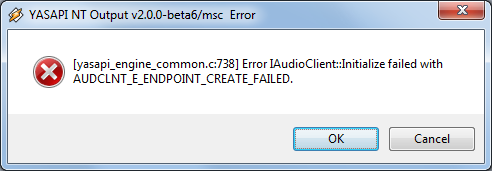
When getting such an error you should cross check
Configuration → Explore.
- This might become v2.0.0.
- Our further plans are
- v2.1.0: volume control, and
- v2.2.0: gapless playback.
|
| 2018-04-22 |
2.0.0-β5 |
- Our preferred mode using this plug-in is double buffered,
i.e. exclusive pulled. With this mode we sometimes observed
that the plug-in got stucked. As a source of this strange behaviour
we identified an underflow of the plug-in's buffer.
- Our solution is in such a case sending silence to WASAPI
instead of reading from the plug-in's buffer and reporting the
incident by means of Dropout counters under Configure
→ Monitor:

- A rule of thumb for configuring the plug-in: Make the buffer as small
as possible but not that small that dropouts occur.
- Introduced preprocessing this WEB page by means of the
m4 macro processor
allowing for a much more flexible way of editing.
|
| 2018-04-20 |
|
- From the

- From the the Lovely Parasite's
 forum: forum:

- Who are those people prefering inferior products just for political reasons?
Obviously they like being replaced by an uncivilized "people" with an IQ
of about 70. Anyway, we're not.
- We doubt that people attracted by the Lovely Parasite
 know
what WASAPI really is. It could be that the Lovely Parasite know
what WASAPI really is. It could be that the Lovely Parasite  itself does
not. We're convinced that they're satisfied by anything labelled "WASAPI" without
asking any further question what's below the hoot. They shood stick with DS,
really: itself does
not. We're convinced that they're satisfied by anything labelled "WASAPI" without
asking any further question what's below the hoot. They shood stick with DS,
really:

|
| 2018-04-20 |
2.0.0-β4 |
The user already mentioned notified us by PM that
selecting a device hadn't worked as expected. This preview release
fixes this (silly) bug. Many thanks again Ralf!
|
| 2018-04-20 |
|
- We've uploaded the (hopefully) fixed version
180412-1003
of the latest GTK runtime.
- The reason the prior attempt was broken was that under the hood of
remaining fully binary compatible the good people from the GTK
team created a dependency to libfribidi-0.dll we'd not packaged.
- In case you're interested in what the unsusual version numbers
mean: They are constructed from the latest time stamp on MSYS2
of all files making up a complete runtime.
- You can view the real versions by means of About → Versions.
As far as we can see this time libgtk hasn't changed at all and
libglib has a minor (but incompatible!) change from 2.56.0
up to 2.56.1:
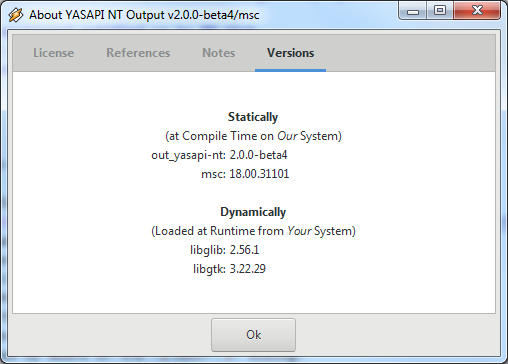
- We're now a step away from
DepenencyWalker
we once used to determine the DLLs needed (a tedious work
we thought we're doing once and for all time) and started
to create a
shell
script determining depencencies automatically by means of the commands
strings
in combination with
grep
(instead of DepenencyWalker).
- Thanks again Ralf!
|
| 2018-04-19 |
|
- A user notified us by PM that the latest GTK runtime published on
SourceForge
is broken (it's not available any longer). Many thanks go out to Ralf!
- For now you should revert to the prior version
180403-0917
or stick to the
expert approach.
- Sorry for any inconvenience.
|
| 2018-04-16 |
2.0.0-β3 |
- Introduced options for defining the
positions
in Z-order of the Configuration and About dialogs, respectively.
- Fixed saving the coordinates of dialogs in case they are not visible.
- Changed some identifiers which may have broken your configuration.
Please double check.
|
| 2018-04-12 |
2.2.0-β2 |
The second preview of what you might expect to come:
|
| 2018-04-11 |
|
We just noticed that on 2018-04-10, 04:19, the following
new thread
appeared at the WA forum:

Might be a fan of us but please note that this message is not ours.
We don't post at the WA forum for years now.
Anyway, we know at least one Lovely Parasite  who likes tricking users into
reporting to him and not to the plug-in's author: who likes tricking users into
reporting to him and not to the plug-in's author:
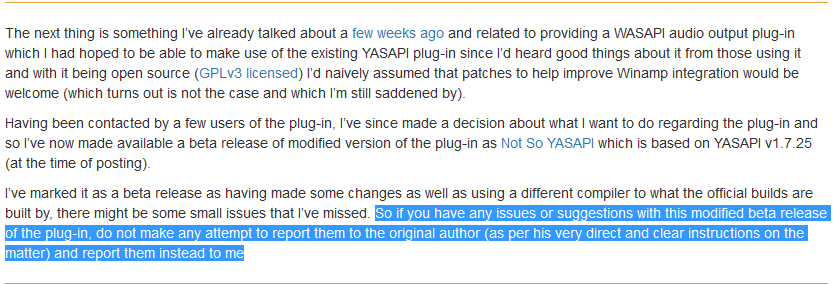
|
| 2018-04-08 |
2.0.0-β1 |
- We're back again: This is a preview of what you might expect to come.
It's re-written from scratch with several improvements, hence we called
it New Technology (NT). It's our attempt getting rid of annoying
nasty Parasites
 because we assume that those Parasites because we assume that those Parasites  are
silly coders just being able to do some silly native
win32 GUI coding based on drawn dialogs created with the help of some
resource editor and hence we no longer provide a
resource file. are
silly coders just being able to do some silly native
win32 GUI coding based on drawn dialogs created with the help of some
resource editor and hence we no longer provide a
resource file.
- This NT version is superior to any prior version by any means and
does let any prior version look just like a silly prototype:
- Exclusive pulled (i.e. double bufferered) playback is
fully supported.
- In case of pushed playback a periodic timer may be utilized.
This allows for a wonderful symmetric solution compared to pulled
playback where no timer is needed at all and playback is triggered in
high accuracy by the device itself.
- Initialization of any resource is deferred until it actually is needed.
This way the plug-in's footprint at Winamp start-up time is the
lowest possible, i.e. you will not notice whether it is installed.
- Avoided any instance of
busy waiting.
In any attempt to fall back on it substituted it by thread
synchronization means, i.e. WaitFor[Single/Multiple]Object[s]()/SetEvent()
or g_cond_wait()/g_cond_signal()
functions, respectively.
- The GUI (i.e. the
Configuration
and About dialogs) were made from the great
GTK+
toolkit.
- You might fear that building on Gtk+ might pose some overhead
compared to a native Windows implementation:
- This is, of course, true.
- But you should note that this is constraint to GUI/configuration
and not to playback.
- As long as you don't make use of the GUI there is no difference to a
plain Windows WASAPI implementation. WASAPI is, of
course, 100% Windows and nothing else.
- Loading the GTK+ DLLs in a Winamp session is deferred
until the Config or About buttons, respectively, are hit
for the first time. To give an impression on the overhead of loading
the GTK+ DLLs we display a wait cursor during the time
it takes. (Be warned and be patient, especially when GTK+ has
to be loaded after re-booting your system!) Once the DLLs required
for GTK+ are loaded there is no measurable difference between
GTK+ and a native Windows GUI.
- Last but not least please remember the above note:
This was the perfect opportunity for us to dive into the world of
GTK+ programming. The result is more than satisfying.
- This preview has the following limitations:
- Format conversions (i.e. monto to stereo and bit depth conversions)
are not implemented yet.
- Volume control is not implemented yet.
- Gapless playback is not implemented yet.
- The documentation is not fully updated yet. (Updating might continue
during the next days.)
The documentation of previous versions is available
here.
|
| 2018-02-16 |
|
Updated
section
Some Additional Notes Regarding the Lovely Parasite  . .
|
| 2017-04-27 |
|
As a sort of side project to out_yasapi we've created
milkdrop2-compile:
|
| 2017-01-10 |
|
Added a political statement to the top
of this page:Nanos gigantum humeris insidentes: This project is dedicated to my European heritage. It is strictly to be understood as a statement against the "sweet" liberal lie of "multiculturalism" which is going to destroy Europe as we know it, in particular against the Merkel regime selling out Europe for nothing as we watch.
|
| 2016-11-10 |
|
To all you great people out there in
the US: Thank you for electing Donald Trump!
|
| 2016-08-11 |
|
Just recently it came to our attention that a creature
calling itself "DrO" (update 2018-04-08: according to
the silly "one world" ideology ruling the so called "western world"
it is just a "human being" without any individual properties
discriminating it from others, just like an ant in
a bath full of infinite many undistinguishible ants; you
shouldn't have any doubt that in a literal sense it
is "equal" to you and me by any means, just like in
liberté, égalité, fraternité


 advertises a silly and buggy clone of this plug-in
with just a few lines of code errornous changed (out of
about 20.000 and his name added to the About box)
he advertises under the name of Not So YASAPI Output
Plug-in. Be careful and get not mixed up!
The original YASAPI plug-in indeed comes from this site and
SourceForge
(as usual!) Luckily and thanks to the GPL3 the "author" of this silly clone
had to leave the original copyright notice and the reference
to this site intact!
advertises a silly and buggy clone of this plug-in
with just a few lines of code errornous changed (out of
about 20.000 and his name added to the About box)
he advertises under the name of Not So YASAPI Output
Plug-in. Be careful and get not mixed up!
The original YASAPI plug-in indeed comes from this site and
SourceForge
(as usual!) Luckily and thanks to the GPL3 the "author" of this silly clone
had to leave the original copyright notice and the reference
to this site intact!
|
| 2016-08-06 |
1.7.25 |
- Parameterized the configure script that it may be
useful for others as well (cf. the new section
Compiling YASAPI from Source
below). It
now supportes the "./configure && make" cycle
well known from UNIX/LINUX systems.
- Fixed the error introduced with the prior version
that YASAPI does not play in pull mode (as reported to the
WA forum)
|
| 2016-07-30 |
1.7.24 |
- Updated my build machine from Vista to Windows 7
(good bye Vista users).
- Hence the new version is build using MSVC 11 / Windows SDK v7.1A
(instead of the respective MSVC 10 / Windows SDK v7.0A under Vista.)
- Dropped the SSE2 versions because by using MSVC 11 they make no
sense any longer.
- As usual, some code clean-up.
|
| 2016-07-19 |
1.7.23 |
|
| 2016-07-15 |
1.7.22 |
|
| 2016-07-12 |
1.7.21 |
|
| 2016-07-08 |
1.7.20 |
|
| 2016-07-05 |
1.7.19 |
|
| 2016-07-03 |
1.7.18 |
- Some final code clean-up before moving on.
- Development ist stalled again.
|
| 2016-07-03 |
1.7.18 |
- Some final code clean-up before moving on.
- Development ist stalled again.
|
| 2016-07-30 |
1.7.17 |
Added the following personal statement to the About
dialog and to the projects home page at
http://out-yasapi.sourceforge.net/:
PLEASE NOTE THAT THIS PROJECT IS AN EXPERIMENTAL RATHER
THEN AN INDUSTRIAL STRENGTH EFFORT. THIS PROJECT IS NOT FOR
YOU. IT IS FOR ME IN ORDER TO LEARN SOMETHING. IF THERE IS SOMETHING
ALONG THE WAY I CAN DO FOR YOU THAT'S GREAT!
|
| 2016-07-30 |
1.7.15 |
Fixed several bugs regarding the implementation of the
device specific option Extend to 24 Bit. This option is
apperently not equivalent to Winamp → Options
→ Preferences → Playback → Playback → Allow 24bit
because the latter reduces bit deps to 16 bit if un-checked otherwise to
24 bit. Bit depth is never extended to 24 bit. YASAPI extends bit depth
to 24 bit those enabling playback on devices which does support 24 bit
WASAPI playback but not 16 bit WASAPI playback.
|
| 2016-06-27 |
1.7.10 |
Added a device specific option in order to define
gwhether YASAPI should promote 8/16 bit input to 24 bit. This is not
greally necessary because the same effect can be achieved by
genabeling Winamp → Options → Preferences → Playback
g→ Playback → Allow 24bit but is provided on user request
|
| 2016-06-23 |
1.7.4 |
- Factored out a framework for simialr plug-ins.
- Connect to the device before continue playing after flush
when in underflow.
|
| 2016-06-21 |
1.7.1 |
Improved migrating the plug-in from an un-plugged default
device to the new default device when playing.
|
| 2016-06-20 |
1.7.0 |
(Limited) support for un-plugging the default device
(as configured via System control) when playing.
|
| 2016-06-19 |
1.6.14 |
- Disconnect on pause and undeflow when option
Disconnect is choosen.
- Removed timer for disconnecting gapless sessions because it is not
needed any longer.
- Fixed crashing of the configuration dialog in case the device
selected in the previous session has meanwhile become invalid.
|
| 2016-06-14 |
1.6.11 |
Fixed combining pause with flush (skip).
|
| 2016-06-13 |
1.6.9 |
- For gapless mode it is configurable after which time interval the
connection should be released when in idle state.
- Reworked the tracing facilities of the debug version.
|
| 2016-06-11 |
1.6.8 |
For the debug version it may be configured that the
trace is written to a file in the AppData/Winamp/Plugin
directory rather then dispalying it in a console.
|
| 2016-06-12 |
1.6.7 |
In gapless mode, when a playlist ends the device is
not released. It is waiting for the next track to start. This situation
is un-distinguishable from an ordinary underflow situation and hence
playback ends in an undeflow state. This may cause trouble when in
such a situation the user decides to change the output plugin (via
configuration). This new version applys to exact this situation:
If in case the user changes the output plugin and this plugin
is found in an underflow state this plugin is closed (and hence the
device released).
|
| 2016-06-12 |
1.6.6 |
Fixes regarding gapless playback.
|
| 2016-06-12 |
1.6.5 |
- Stopping player when Winamp closes and not already stopped
(needed for gapless mode).
- Guarding against locking zero sized device buffers.
- Reworked About dialog.
|
| 2016-05-29 |
1.6.4 |
Added a common option in order to define whether 4, 6, or 8 channels should
be interpreted as qadrophnic (3.1), 5.1, or 7.1 (disabled) or sorround (3.1 sorround),
5.1 sorround, or 7.1 sorround (enabled), respectively.
|
| 2016-05-26 |
1.6.3 |
- Fixed AUDCLNT_E_BUFFER_SIZE_ERROR appearing in
eclusive/pull mode.
- Fixed a potential forever-loop which may have appeared at
the end of a track.
- Fixed crashing as client of the
WinampMatrixMixer output plugin.
|
| 2016-05-22 |
1.6.0 |
- Gapless playback.
- A common option for switching on/off gapless playback (disabled by
default).
- A device option for choosing whether the time offset for gapless playback
is maintained as a 64-bit integer value (representing the playback
position) or as a 64-bit floating point value (representing the quotient
taken from the playback position and a frequency). For a deeper
understanding regarding position and frequency values you may refer to
the documentation of the
IAudioClock::GetPosition()
and
IAudioClock::GetFrequency()
methods. We feel that as long as a constant frequency value can be
assumed choosing the time offset as beeing maintained as a 64-bit integer
value is preferable.
- A debug version for SSE2.
|
| 2016-05-17 |
1.5.4 |
Solved the dead-lock caused by saving the configuration.
|
| 2016-05-17 |
1.5.3 |
Improved dealing with draining the ring buffer and end of track (eot).
|
| 2016-05-16 |
1.5.0 |
- The Default Device is listed in the respective configuration dialog's
drop down box as an option to choose.
- In case the Default Device is choosen from the drop down box (and saved),
- the configuration is saved for the physical device which was configured at
the time (configuration time) as Default Device from
Window's System Control when the configuration was loaded to the dialog,
- each time a new track starts, the physical device configured at this time
(play time) as Default Device from Window's System Control
is used to play the track (please note that this device may differ from the one
configured at configuration time).
Please note that this is a complete re-write. Everything was thrown into peaces,
something into larger building blocks and something into dust. The larger building
blocks, which greatly remained intakt, could be re-used. The dust had to be thrown
away and substituted by a new development. Please be careful in using this new
version, thoroughly test it and re-configure it, if needed.
|
| 2016-04-09 |
1.0.7 |
In order to have YASAPI in a well defined state from the very first beginning,
reset the
IAudioClient
interface at start-up.
|
| 2016-01-13 |
1.0.6 |
- Detect end of track by respective "isplaying" request.
- Fixed bug regarding synchronization of Share Mode and Strategy options.
|
| 2016-01-09 |
1.0.0 |
|
| 2016-01-03 |
1.16.0 |
- Guarded against writing when paused.
- Stopping audio client when underflow.
- From the configuration dialog, dropped the device list page in favour of a combobox on top of the dialog.
- Slightly adapted default values.
|
| 2015-12-21 |
1.16.5 |
Brought back, as an option, a call to
IAudioClient::IsFormatSupported
which is disabled by default.
|
| 2015-12-10 |
1.14.1 |
Increased default ring buffer size to 2.5.
|
| 2015-12-08 |
1.14.0 |
- Introduced an (by default enabled) option "Write Block" that in case the plugin's "write" method delivers more data than actually could be written to the ring buffer it should block and wait until enough data are consumed from it rather then returning immediately.
- For automatic mode, removed restrictions for switching from exclusive to shared mode.
|
| 2015-12-04 |
1.11.0 |
- Reorganized the configuration dialog:
- Focused again on the most important two (per device) parameters "Mode" (share/exclusive) and "Strategy" (push/pull).
- Duplicated those two parameters from the "Device Options" page to the dialog's top-region.
- Moved the former top-region parameters to a new "General" tab-control page.
- Added a "Store" button with similar functionality as the "OK" button except that it doesn't close the dialog.
- Fixed several bugs.
|
| 2015-11-29 |
1.10.0 |
- Reorganized configuration of device period.
- Added progess bars to the configuration dialog in order to visualize the load of the
ring and the shared buffers.
- Added an option for dis-/enabling the visualization.
- Added an (experimental) function for balancing the shared buffer.
- Added some more tracing to the debug version.
- Split the verbose debugging into verbose level 1 ond and level 2 (even more verbose).
|
| 2015-11-23 |
1.9.1 |
- Added an option for configuring whether calculation of the buffer sizes should be based
on the default or on the minimum device period as proposed by WASAPI. Made default device
period the default. So long the calculation was silently based on the minimum device period.
- Added tooltips to the configuration dialog's controls.
|
| 2015-11-22 |
1.9.0 |
- Complete re-write based on a new architecture.
The basic idea is to serialize all requests and dispatch them into just one worker thread.
In particular the serialization takes into account asynchronous requests resulting from the WASAPI device.
- Round up ("ceil") the size of the ring buffer to the next multiple of Winamp's packet size (576 samples).
- Special treatment of double buffering, i.e. pull in exclusive mode.
- Additional options to configure the debug version.
Note: You should re-configure at least the buffer sizes.
As a rule of thumb all buffer sizes should be 1.0 except the ring buffer's size which
should be just a small amount greater then 1.0.
|
| 2015-11-02 |
|
- Improved thread synchronization during start-up.
- Fixed a bug regarding recovery from error AUDCLNT_E_BUFFER_SIZE_NOT_ALIGNED
of the IAudioClient::Initialize() method.
|
| 2015-10-31 |
1.8.2 |
|
| 2015-10-30 |
1.8.1 |
New share mode "automatic" which is similar to exclusive except
that it falls back to shared in case exclusive fails.
|
| 2015-10-29 |
1.8.0 |
- Improved synchronization with visualizations and video because of
- corrected calculation of max latency and
- corrected calculation of "written time".
- Dropped "written time" options.
- Dropped the call to
IAudioClient::IsFormatSupported().
- New device specific options "Auto Convert PCM" and "SRC Default Quality". These Options are only available in shared mode.
They correspond to the
AUDCLNT_STREAMFLAGS_AUTOCONVERTPCM
and
flags, respectively, of the
IAudioClient::Initialize() method
(regarding the AUDCLNT_STREAMFLAGS_SRC_DEFAULT_QUALITY flag cf. also
here).
|
| 2015-10-26 |
1.7.1 |
- Automatic re-sampling in shared mode seems to work now.
- Added an "Exit Winamp" option to the error message dialog box.
|
| 2015-10-26 |
1.7.0 |
- Support for multiple devices.
- Configuration options per device.
- Various fixes.
Note: Prior configuration for the default device may be lost. Please re-configure.
|
| 2015-10-03 |
1.6.1 |
Corrected a silly bug in testing for share mode.
|
| 2015-10-03 |
1.6.0 |
Add AUDCLNT_STREAMFLAGS_AUTOCONVERTPCM
flag when in shared mode (doesn't have any effect on Vista).
|
| 2015-02-14 |
1.5.0 |
- Utilization of the
IAudioClock
interface instead of the
GetTickCount()
or the
timeGetTime()
functions for reporting the elapsed time to Winamp.
- Option for controlling whether "written time" should be calculated.
|
| 2015-01-30 |
1.4.0 |
- Option for treating mono as stero (default switched on).
- New default options for buffer configuration.
- Some fixes.
|
| 2015-01-25 |
1.3.0 |
- Support for pull strategy.
- Support for volume control.
|
| 2015-01-24 |
0.2.1 |
- Component Object Model (COM) error messages are displayed
with the file and the line number where they occur.
- Compiled with shared "MSVCR110.DLL"
(instead of static as before).
|
| 2015-01-24 |
0.2.0 |
- Improved configuration for buffer sizes.
- Provided a SSE2 version.
- Compiled with the C compiler from "Visual Studio 10 Express"
(instead of "Visual Studio 9 Express" as before).
|
| 2015-01-23 |
0.1.0 |
Initial release. |






























































